7 Famous Spots to Enjoy the Japanese Tradition of Cherry Blossom Viewing
In Japan, cherry blossoms herald the arrival of spring. Although the cherry blossoms are only in bloom for a fleeting two-week period, many people gather under the cherry blossom trees to admire the beautiful and fragile petals, from the opening of the first blossoms, to full bloom and finally the spectacular falling petals.
Somei Yoshino, the most widely planted and familiar species of cherry blossom tree in Japan, is known for its spectacular flowers, which bloom in abundance on each branch. Every year in March, there are many people who enjoy following the progress of the cherry blossoms by checking the "cherry blossom front," which forecasts the expected blooming dates of the Somei Yoshino in various regions of Japan, on news and other media.
As the cherry blossom front begins in the southern portion of Japan and travels north, the cherry blossoms in Tohoku (situated in the north part of Honshu) bloom relatively late. Of Tohoku's many great cherry blossom viewing locations, we will introduce you to 7 particularly famous spots.
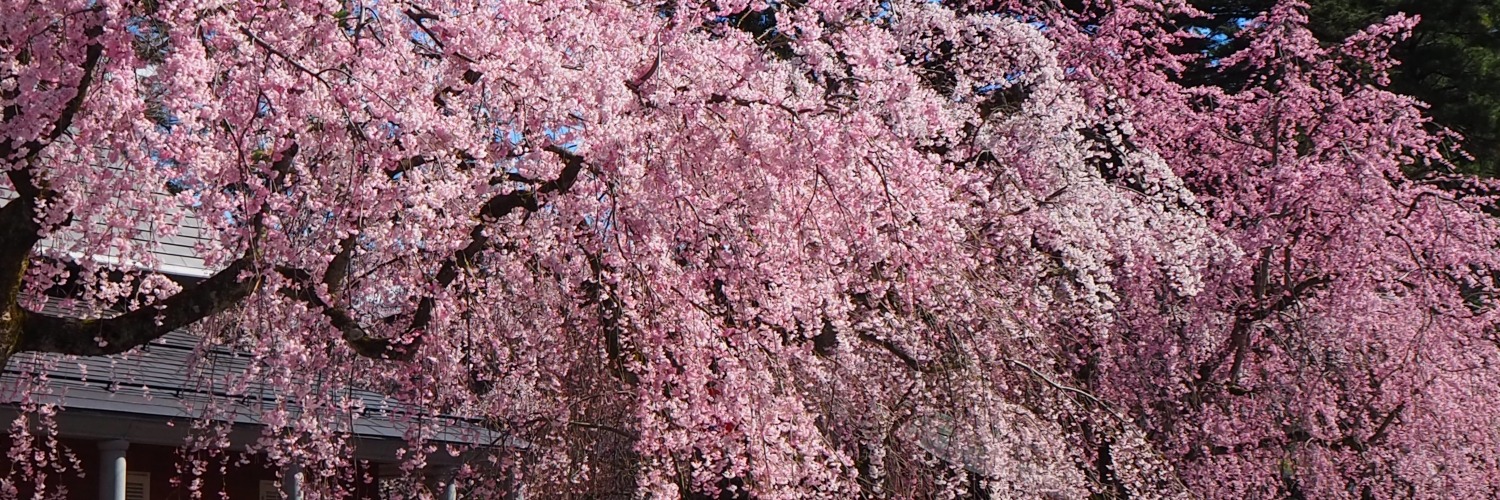
Takada Castle Site Park's Breathtaking Evening Cherry Blossom Display (Niigata)
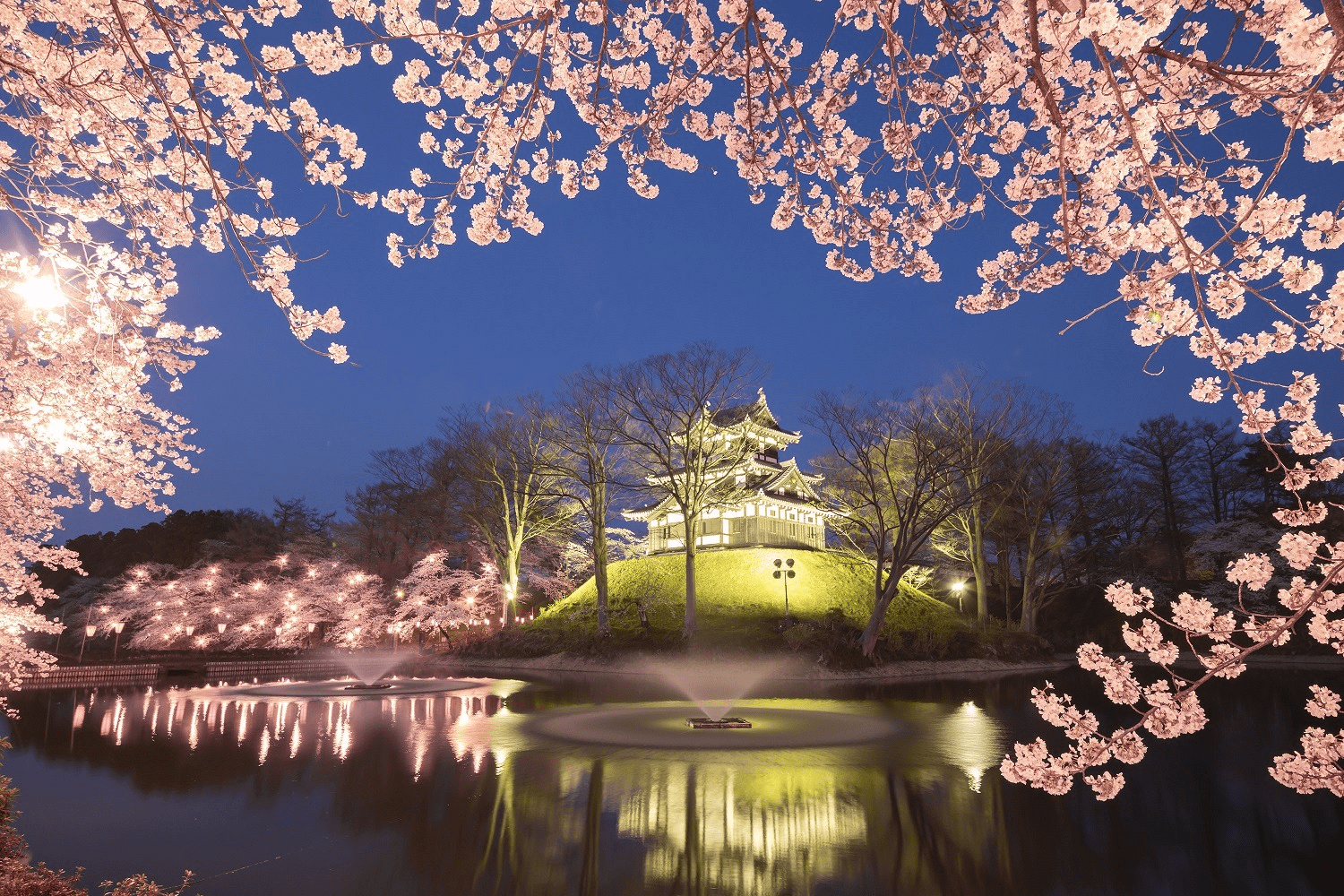
Photo: Joetsu Tourism Convention Association
Takada Castle Site Park was built on the site of the former Takada Castle, which was the residence of Matsudaira Tadateru, the sixth son of Tokugawa Ieyasu, who founded the Edo shogunate. Covering a large area of approximately 50 hectares, it is one of the largest city parks in Japan. Attractions within the park include a restored three-story turret, cultural and sports facilities, and a promenade around the outer moat.
Takada Castle Site Park is known across Japan as a famous cherry blossom viewing spot. The area including the inner and outer moats surrounding the park is filled with approximately 4,000 cherry blossom trees which attract many visitors to the park when in full bloom.
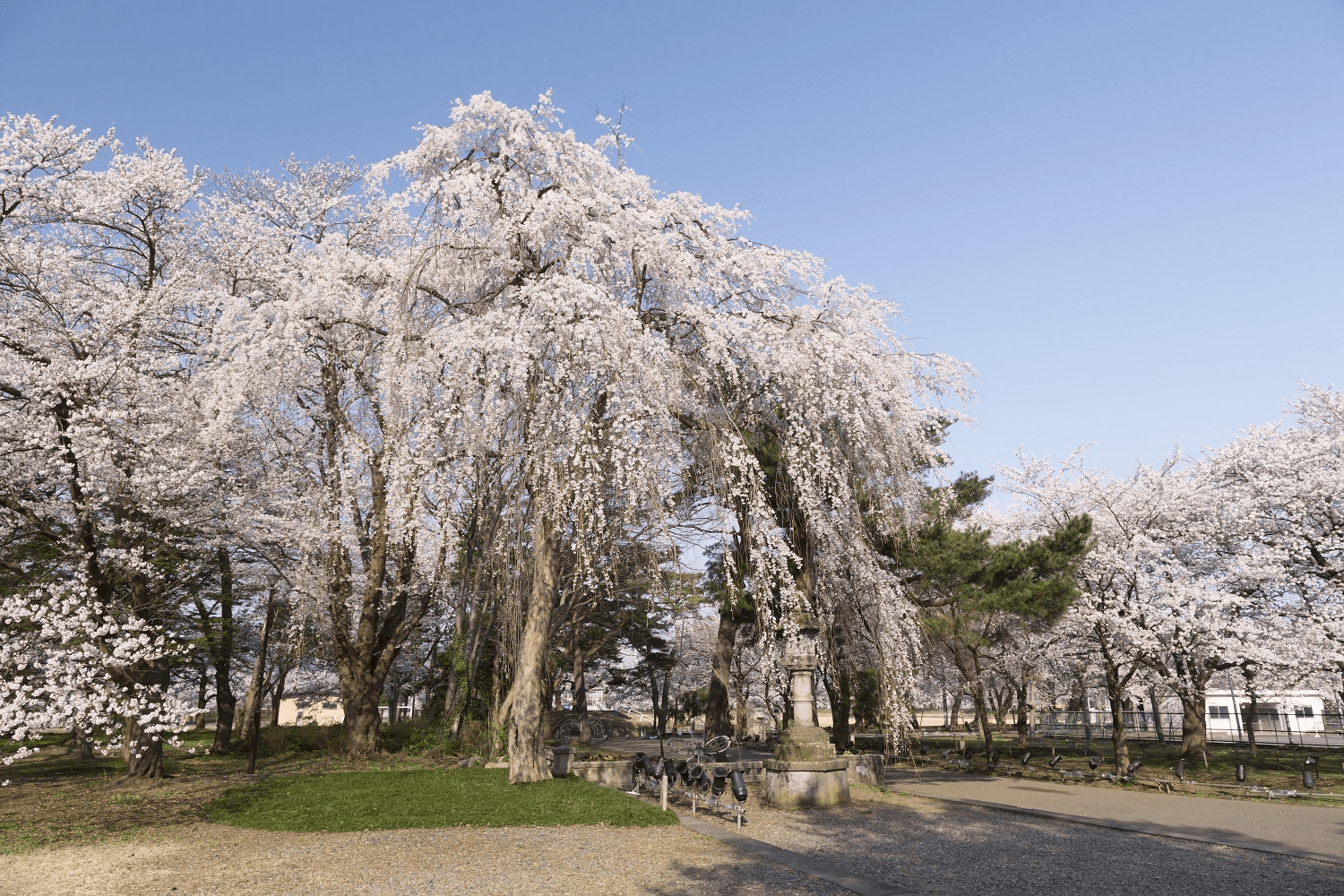
Photo: Joetsu Tourism Convention Association
The most well-known sight of all is the spectacular view of the cherry blossoms at night when they are lit up by 3,000 paper lanterns, creating an enchanting and beautiful scene. The illuminated three-story turret, the light-covered cherry blossoms, and their reflections on the surface of the moat make for a magical sight, the beauty of which has earned the park a place among Japan's three greatest cherry blossom night views alongside Hirosaki Park in Hirosaki, Aomori Prefecture, and Ueno Park in Taito Ward, Tokyo.
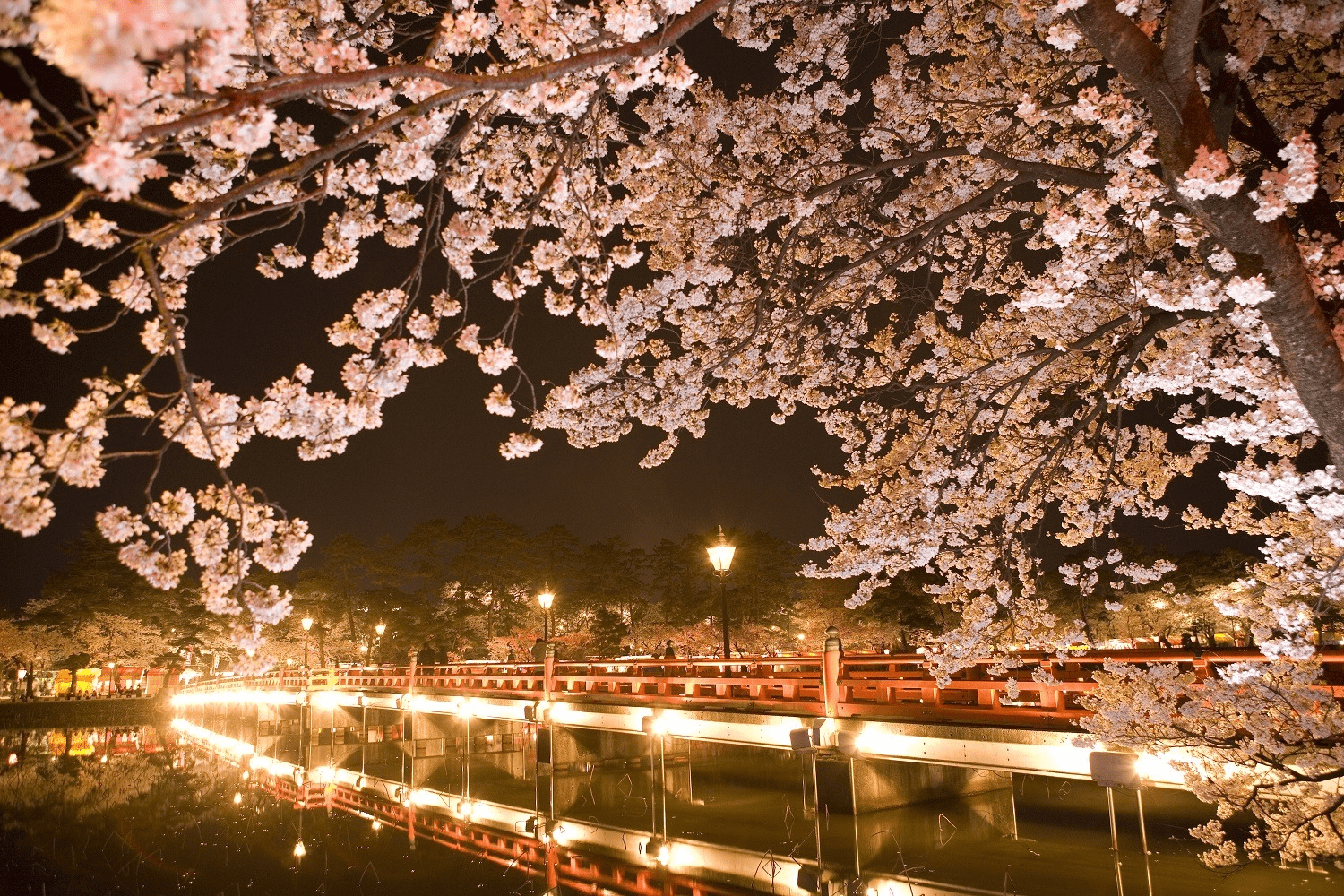 Photo: Joetsu Tourism Convention Association
Photo: Joetsu Tourism Convention Association
You can admire the dainty blooms of pale pink cherry blossom trees during the daytime too, when visitors can enjoy walking down the Cherry Blossom Road through a tunnel of cherry blossoms, admiring the picturesque scenery backed by the snow-capped Mt. Myoko.
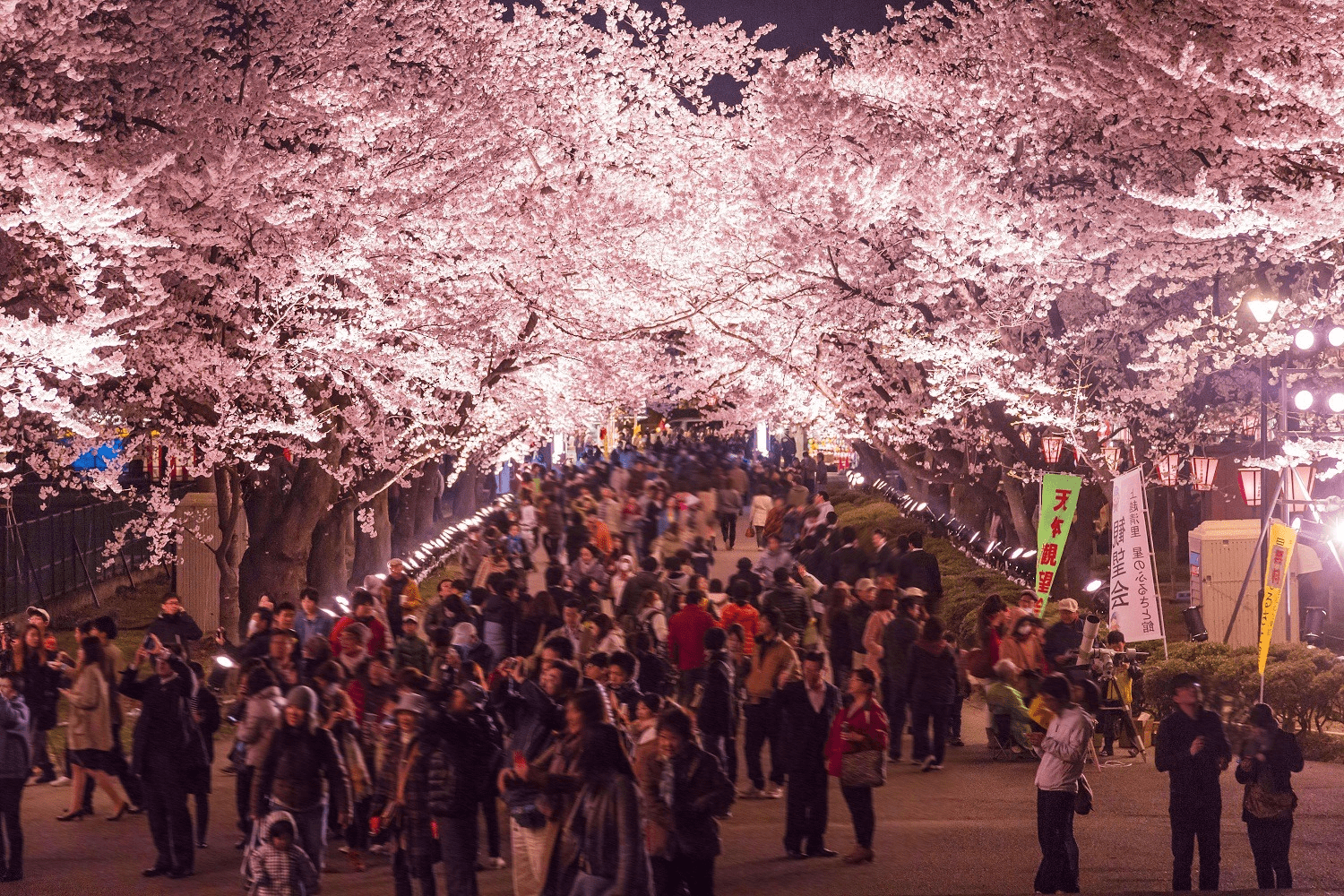
Photo: Joetsu Tourism Convention Association
The 99th Takada Castle Site Park Cherry Blossom Festival, during which the park will be illuminated at night, is scheduled to be held from March 29 to April 14, 2024. Every year, many stalls are set up during the festival, and visitors make the most of the Echigo region's springtime by enjoying the cherry blossoms while eating and drinking.
Kajo Park Plays Host to an Elegant Hanami Cherry Blossom Viewing Festival (Yamagata)
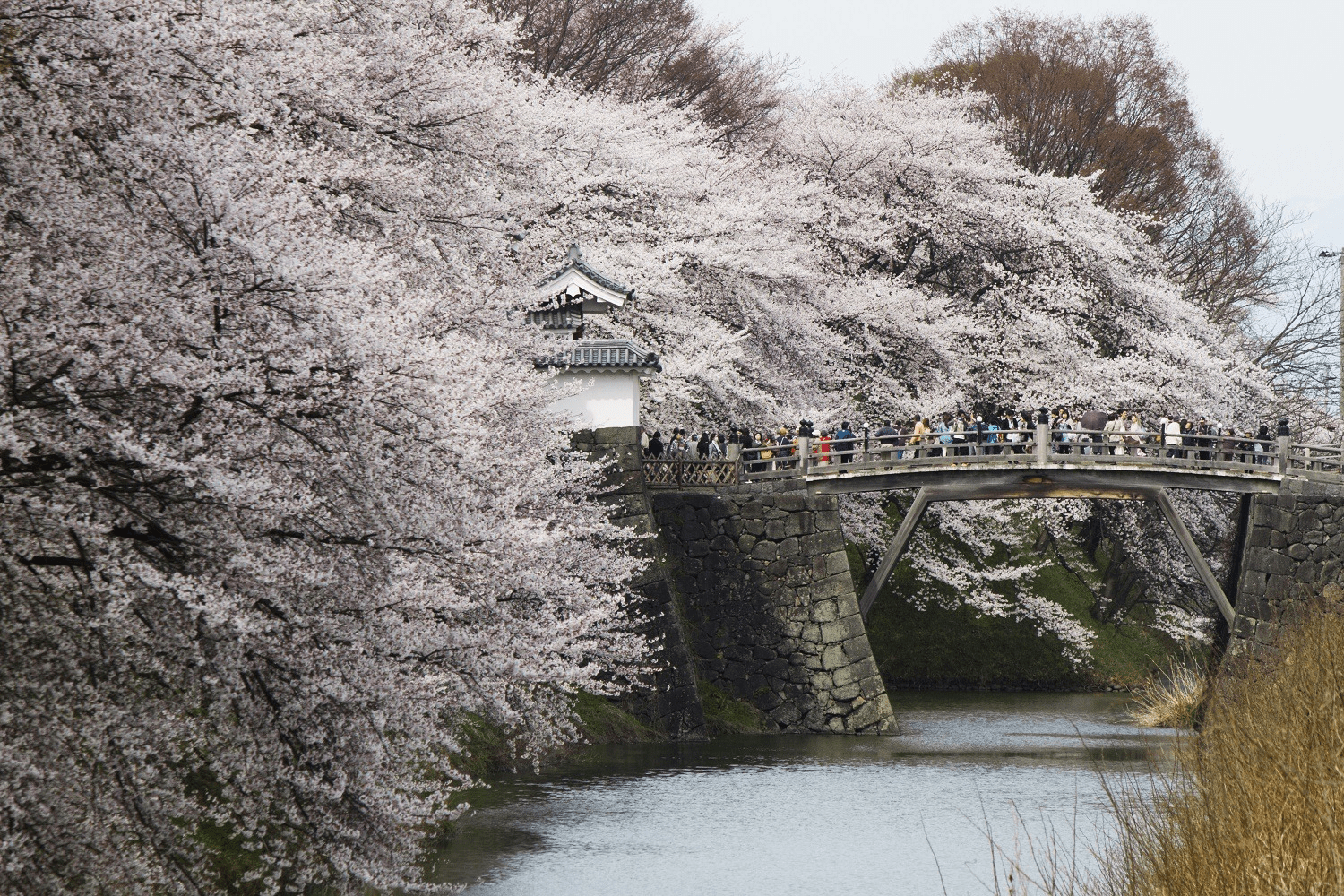
Yamagata Castle was the largest castle in the Tohoku region during the Edo period, covering an area of about 235 hectares. The ruins of the Honmaru and Ninomaru are now maintained as part of the city park, Kajo Park. Stone walls and earthen mounds of the castle still stand in the vast park which is about eight times the size of the Tokyo Dome. The Ninomaru Higashi Otemon gate and Honmaru Ichimonjimon Otebashi bridge have also been restored, recreating the atmosphere of the old days. The large site has also been developed for cultural and sports facilities, making it a popular place for citizens to relax and enjoy themselves.
In Kajo Park, spring is the most spectacular season of the year, with approximately 1,500 cherry trees blooming all at once. During the day there is a beautiful contrast between the cherry blossoms and the white wall of the Higashi Otemon east gate, and after the sun goes down the cherry blossoms are lit up, creating a fantastic juxtaposition with the grand castle architecture. It is a spectacular sight which puts a smile on the faces of many visitors every year.
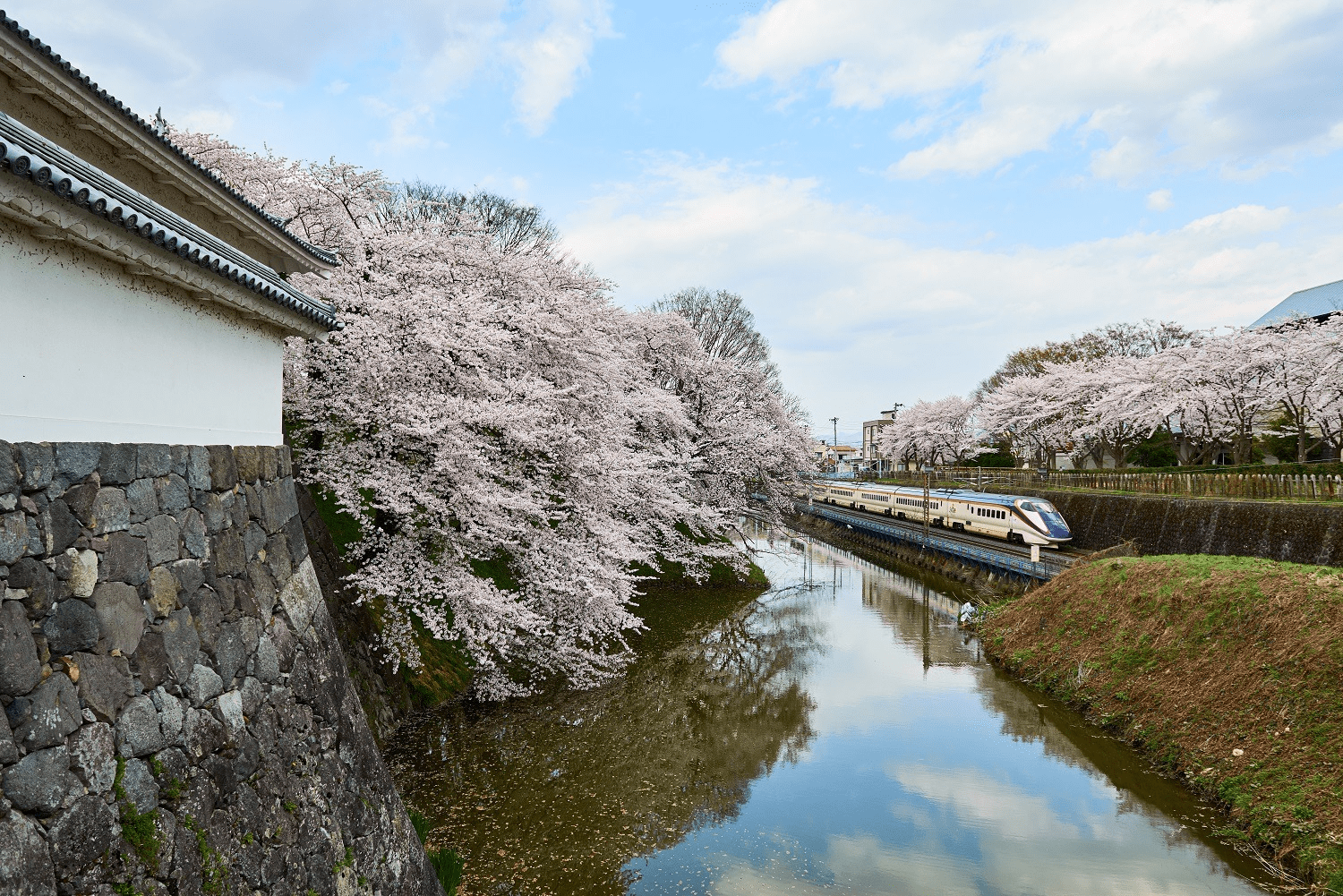
Rows of cherry blossom trees bloom atop the earthen mounds that stand on the inner side of the moat that surrounds the site. The best place to view these cherry blossoms is near the Ninomaru Higashi Otemon Otebashi, which marks the main entrance to the Ninomaru. Here, the cherry blossoms, with branches stretching out from the earthen mounds to just above the surface of the moat, are reflected in the mirror-like water, creating an elegant view.
As you pass through the Otemon gate, a heroic equestrian statue of Mogami Yoshiaki, the first lord of the Yamagata Domain stands before you. This is a popular photo spot where you can capture the equestrian statue and the cherry blossoms together with your camera.
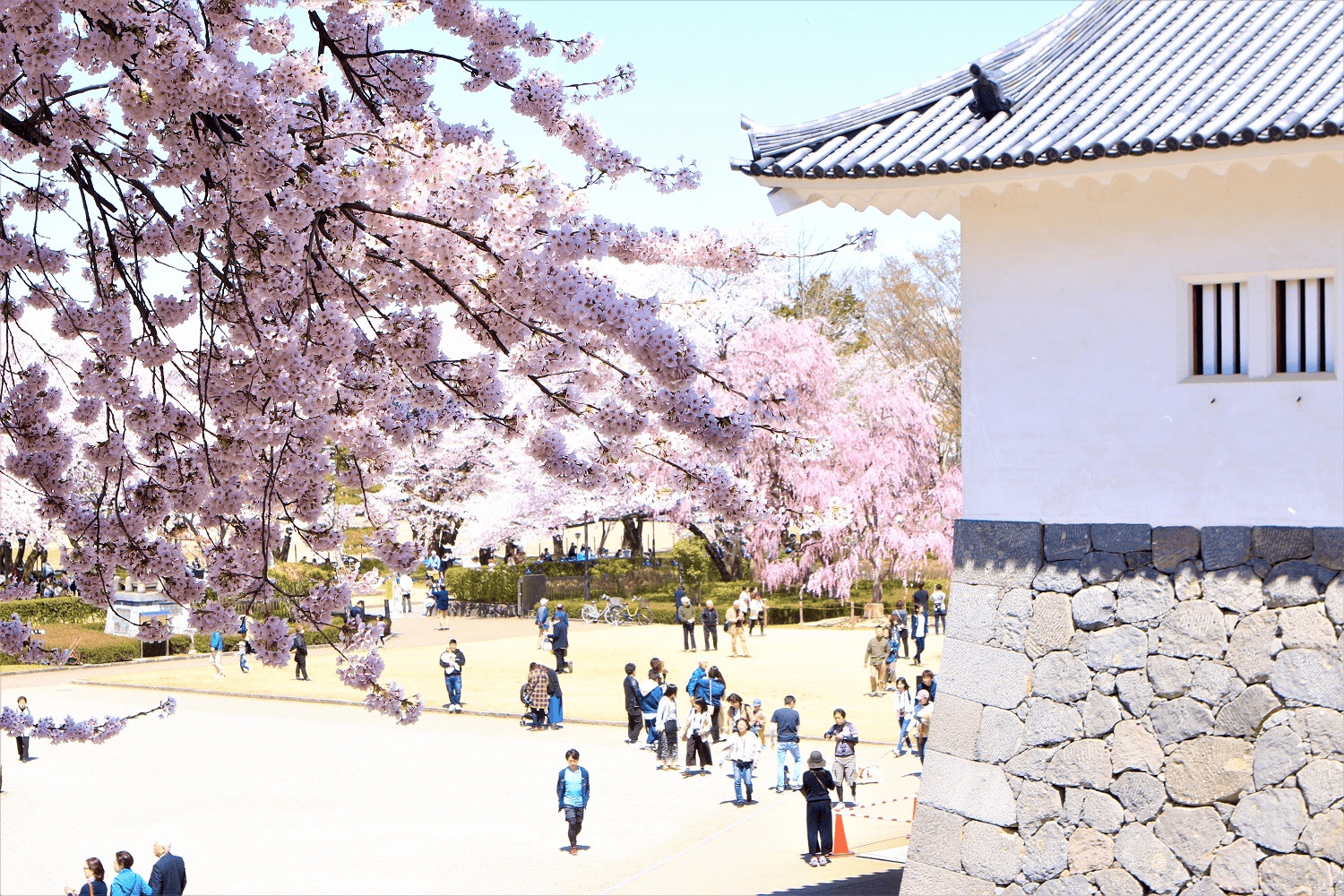
The Ninomaru earthen mounds path, located along the earthen mounds surrounding Ninomaru, is also an excellent viewing spot. Approximately 2.2 km in circumference, the path is densely lined with cherry trees, and visitors can enjoy viewing cherry blossoms as they walk through a tunnel of cherry blossom trees.
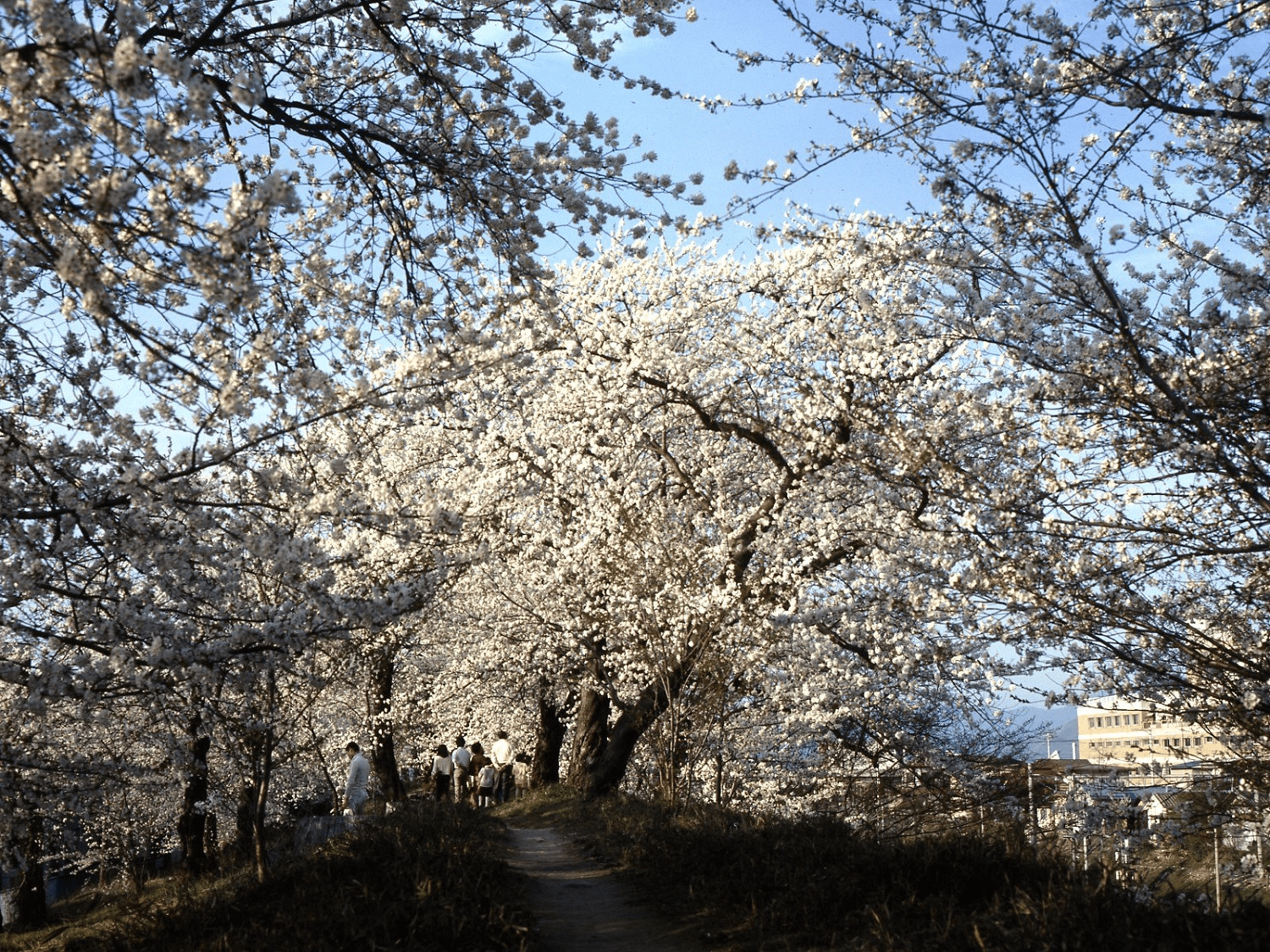
The best time to view the cherry blossoms at Kajo Park is usually from early to mid-April. The Kajo Kanokai cherry blossom viewing festival is held during the period from when the cherry blossoms begin to bloom to when they start to fall (usually around mid-April), and the area along the moat is lit up at night. Various events such as tea ceremonies and koto music performances are scheduled to be held on weekends.
Hitome Senbonzakura Offers Stunning Views of Rows of Cherry Blossoms Backed by the Zao Mountain Range (Miyagi)
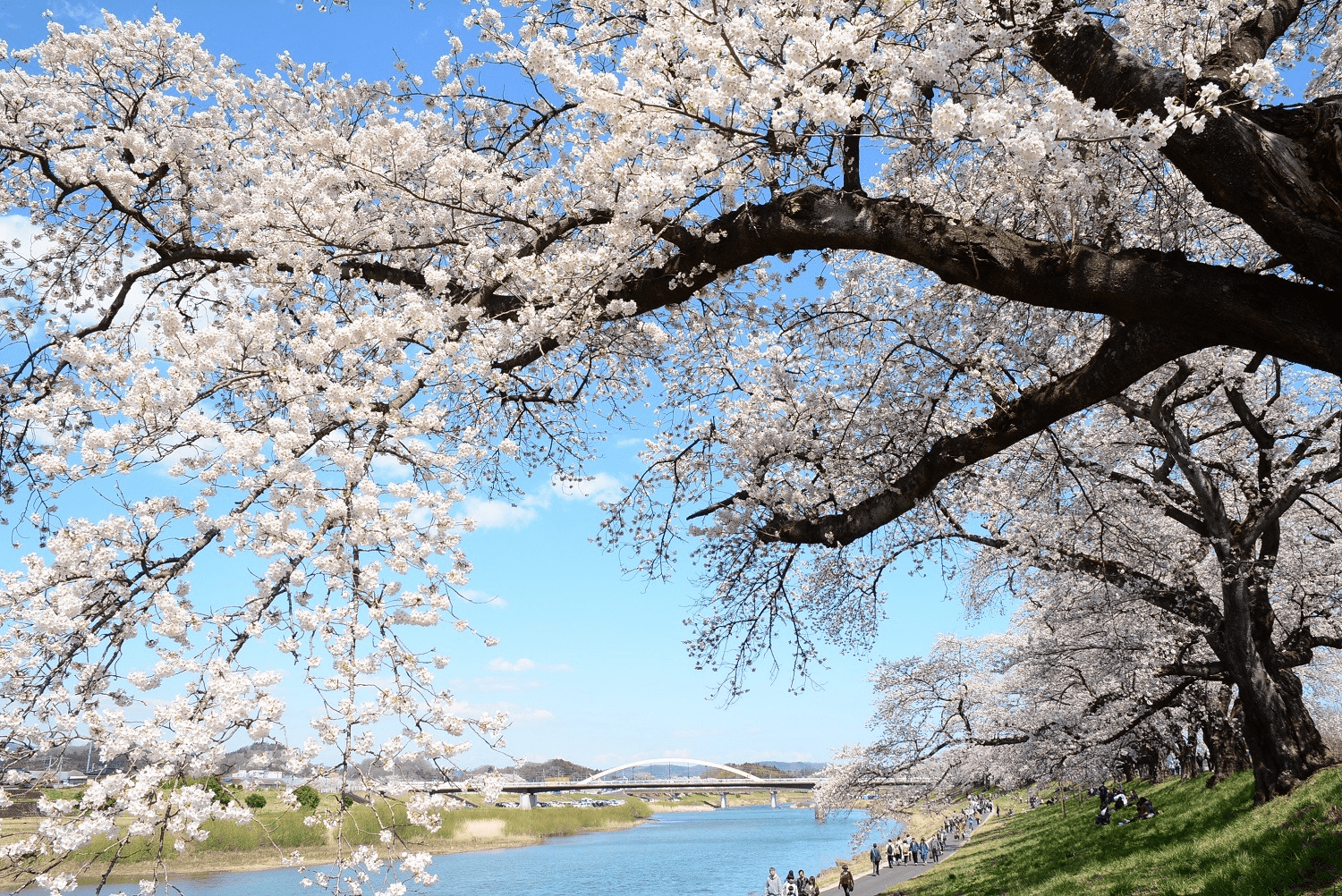
The banks of the Shiroishi River that runs through the center of Ogawara Town and Shibata Town in Miyagi Prefecture are home to the famous Hitome Senbonzakura cherry blossom viewing spot, where approximately 1,200 cherry blossom trees bloom over a distance of about 8 kilometers. Many of the trees planted in the Taisho era are more than 100 years old, and voluminous flowers bloom from the wide spreading branches of each tree.
When the cherry blossoms are in full bloom, you can enjoy a magnificent and harmonious view of the Shiroishi River with cherry blossoms reflected in its clear waters and the distant Zao mountain range capped with lingering snow.
The bank of the Shiroishi River has been made into a promenade where visitors can stroll while admiring the cherry blossoms. The best place to take a stroll is along the 3.5-km stretch between Ogawara Station and Funaoka Station on the JR Tohoku Main Line that runs along the Shiroishi River, where you will be able to fully experience the grandeur of the seemingly endless rows of cherry trees.
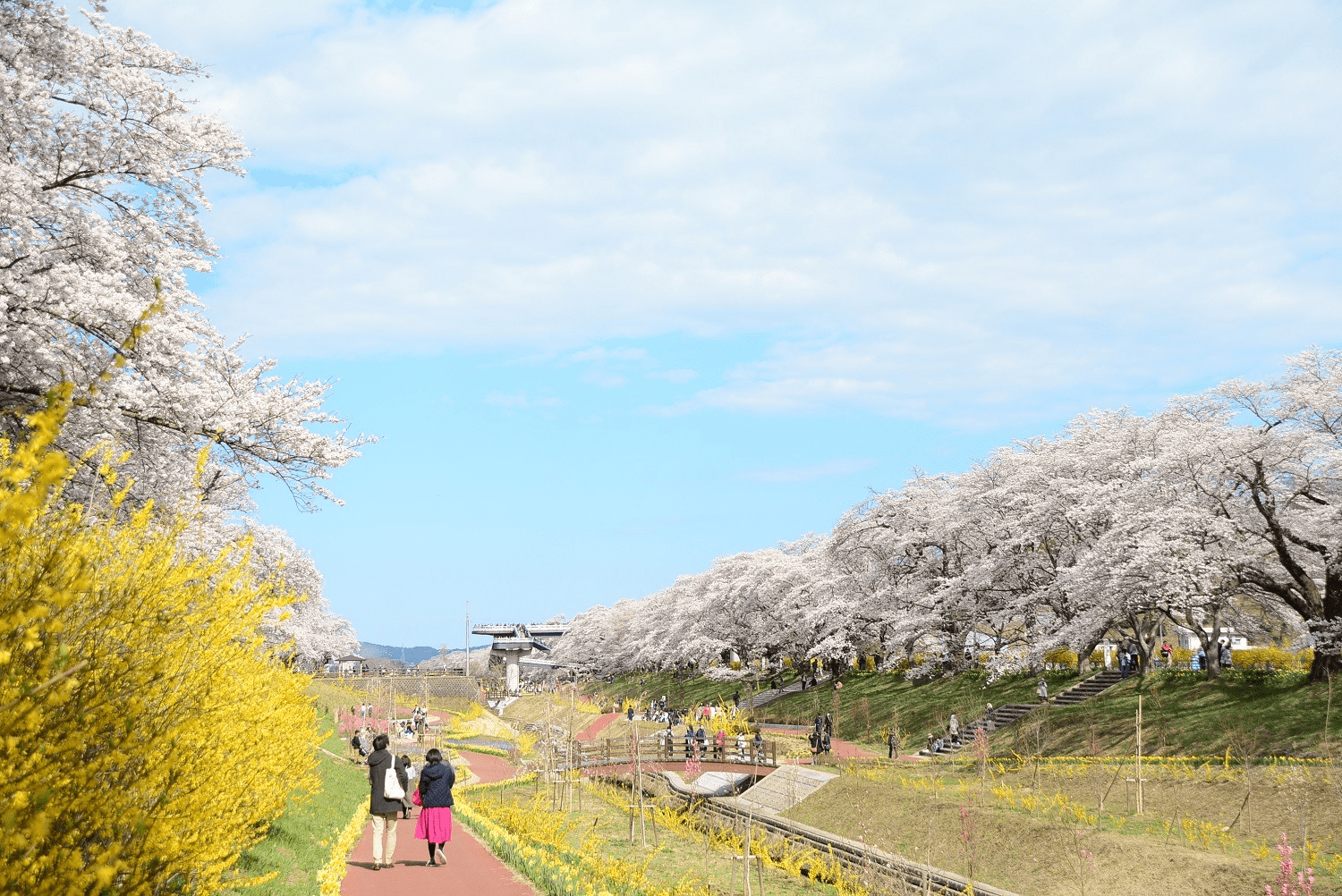
This section of the trail is lined with pedestrian-only bridges, such as the Suehiro Bridge, the Shibata Sen-oukyo Bridge, and the Sakura Bridge, from which visitors can see rows of cherry trees stretching into the distance in just one glance. The area around Niragamizeki, a 10-minute walk from the Suehiro Bridge, is also a popular scenic spot. Here, the refreshing sound of the Niramigaseki's flowing water, along with the rows of cherry blossoms and the Zao Mountain Range are woven together into a stunning panoramic view. At Shiroishi River Sen-ou Park, about an 8-minute walk from Niragamizeki, you can also enjoy the scenery of rose-pink cherry blossoms, yellow forsythia, and red peach blossoms blooming in competition with each other.
If you are tired of walking, we recommend enjoying the view of the cherry blossoms from a train window. During the cherry blossom period, the train will slow down as it passes by the rows of cherry blossoms.
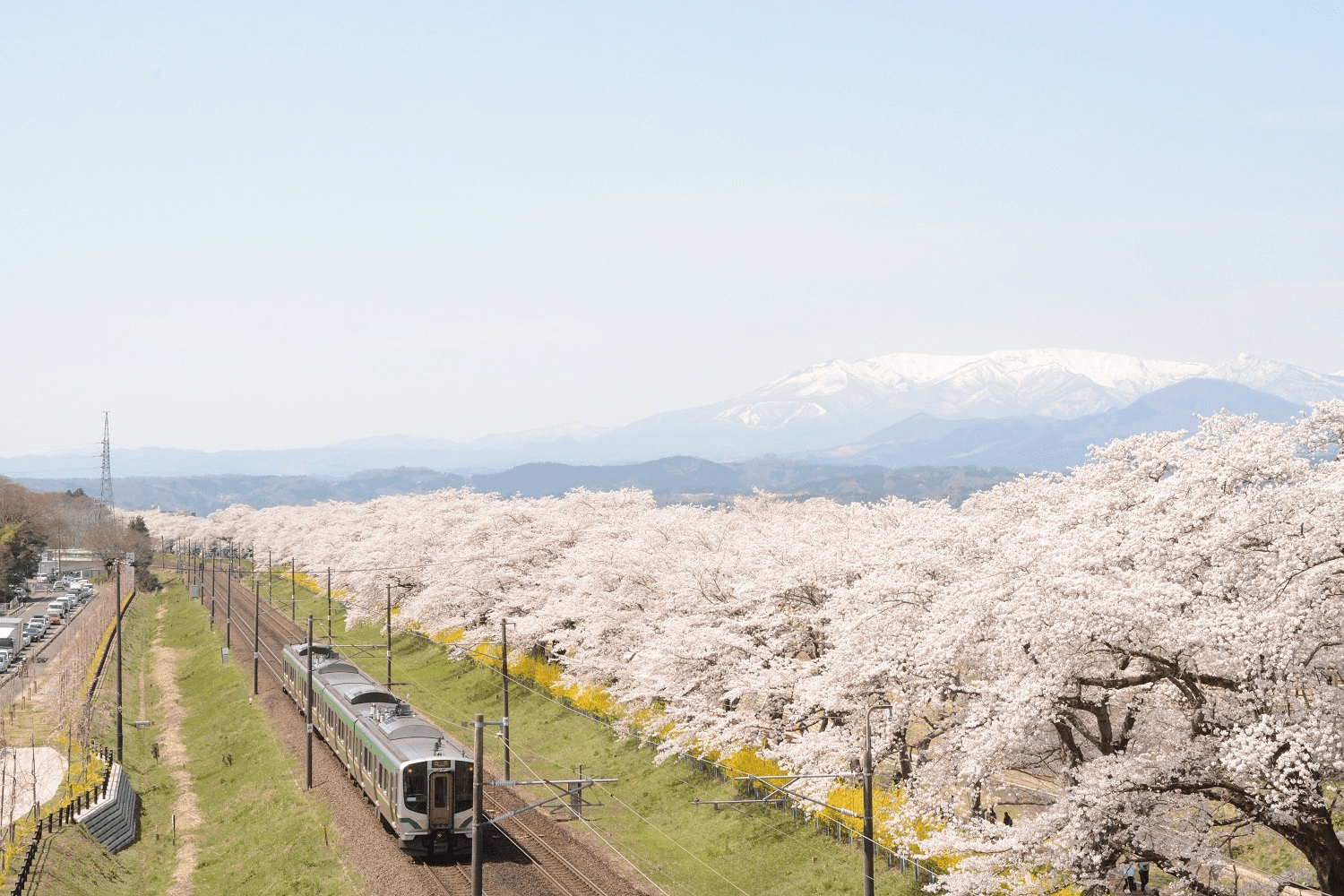
The best time to view the Hitome Senbonzakura cherry blossoms is from early to mid April. The 2024 Ogawara Cherry Blossom Festival is scheduled to be held during the period of blooming, with various stalls and illumination of the cherry blossoms at night.
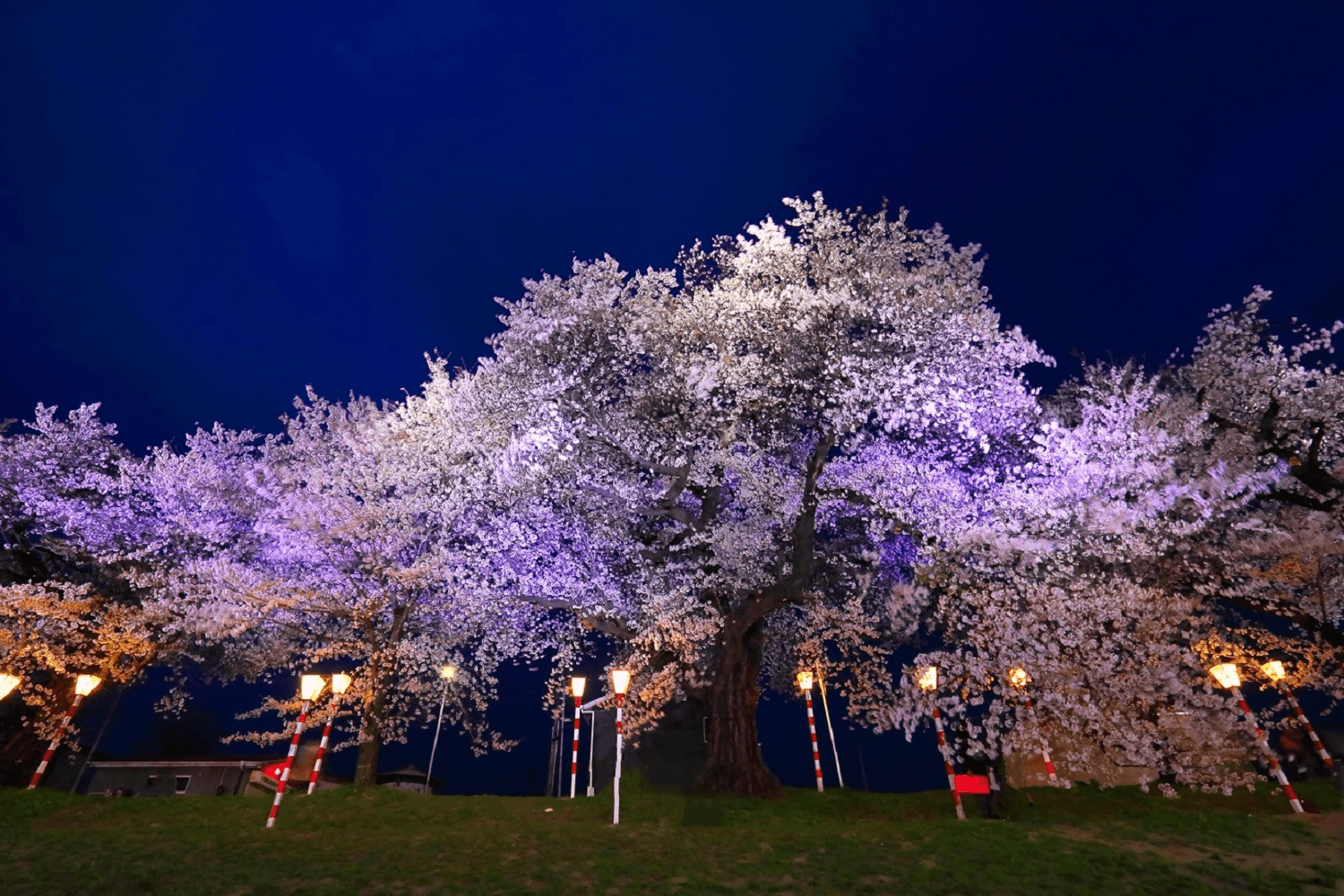
The Nicchu Line Weeping Cherry Blossoms Form Japan's Greatest Cherry Blossom Tunnel (Fukushima)
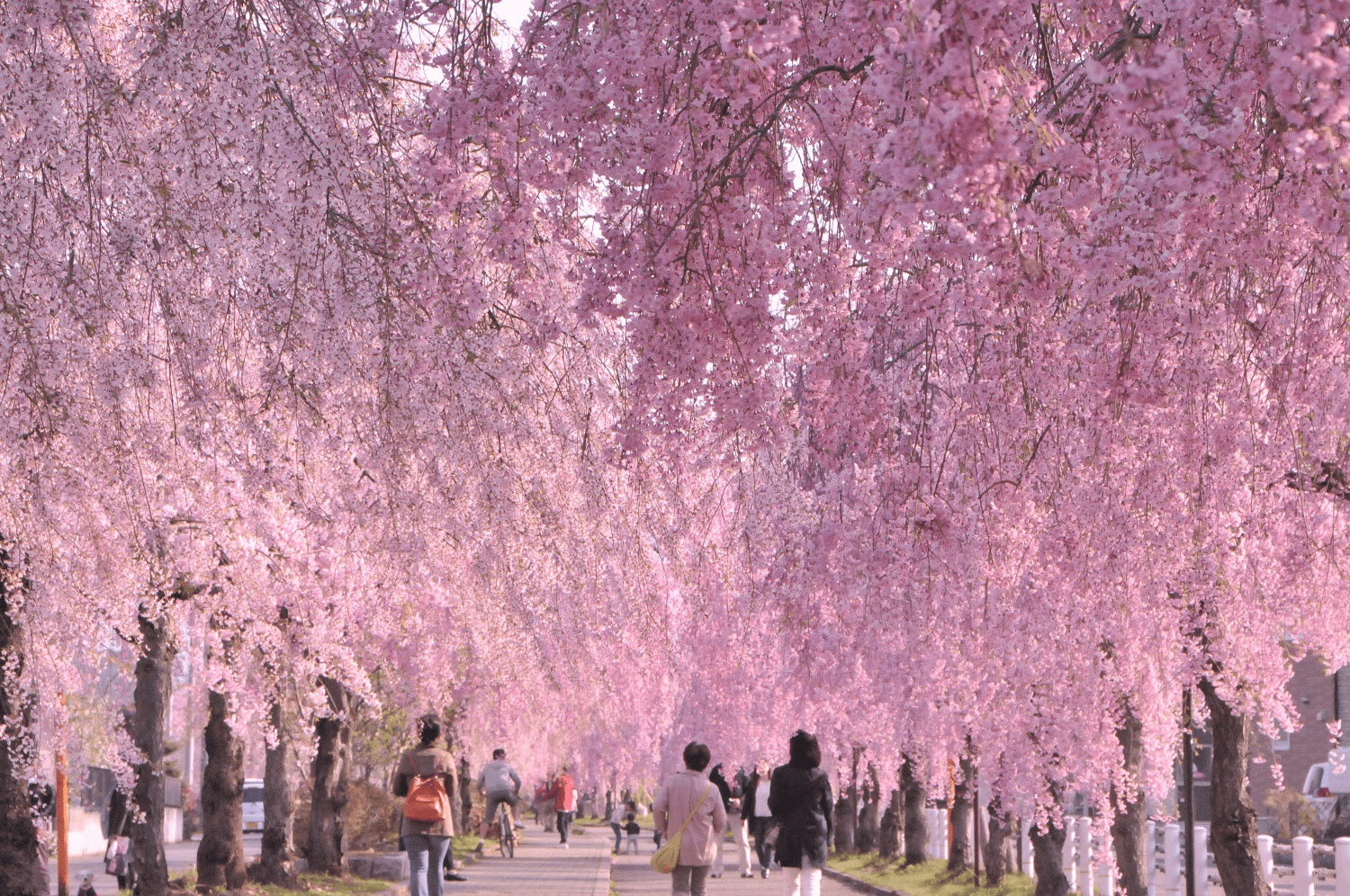
Photo: Kitakata Tourist Product Association
Steam and diesel locomotives ran 11.6 kilometers of the former Japan National Railways Nicchu Line in Kitakata City, Fukushima, from 1938 to 1984. The line played a major role as a means of transportation for residents as well as freighting of goods. After the line was closed down, part of the site was developed into a bicycle and pedestrian path, and the weeping cherry blossom trees that were planted there bloom beautifully every spring.
The weeping cherry blossom trees are planted from the entrance of the promenade, which is located on the west side of JR Kitakata Station, about a 5-minute walk away. The area is overwhelmingly beautiful, with around 1,000 weeping cherry blossom trees blooming across the 3km long promenade. The weeping cherry trees have a gorgeous shape like a cascading waterfall, with deep pink flowers blossoming on their magnificent branches. A stroll along the promenade in full bloom is like being surrounded by a shower of cherry blossoms falling from the sky. The boardwalk is planted with trees on both sides, creating a tunnel of cherry blossoms, making it a popular photo spot.
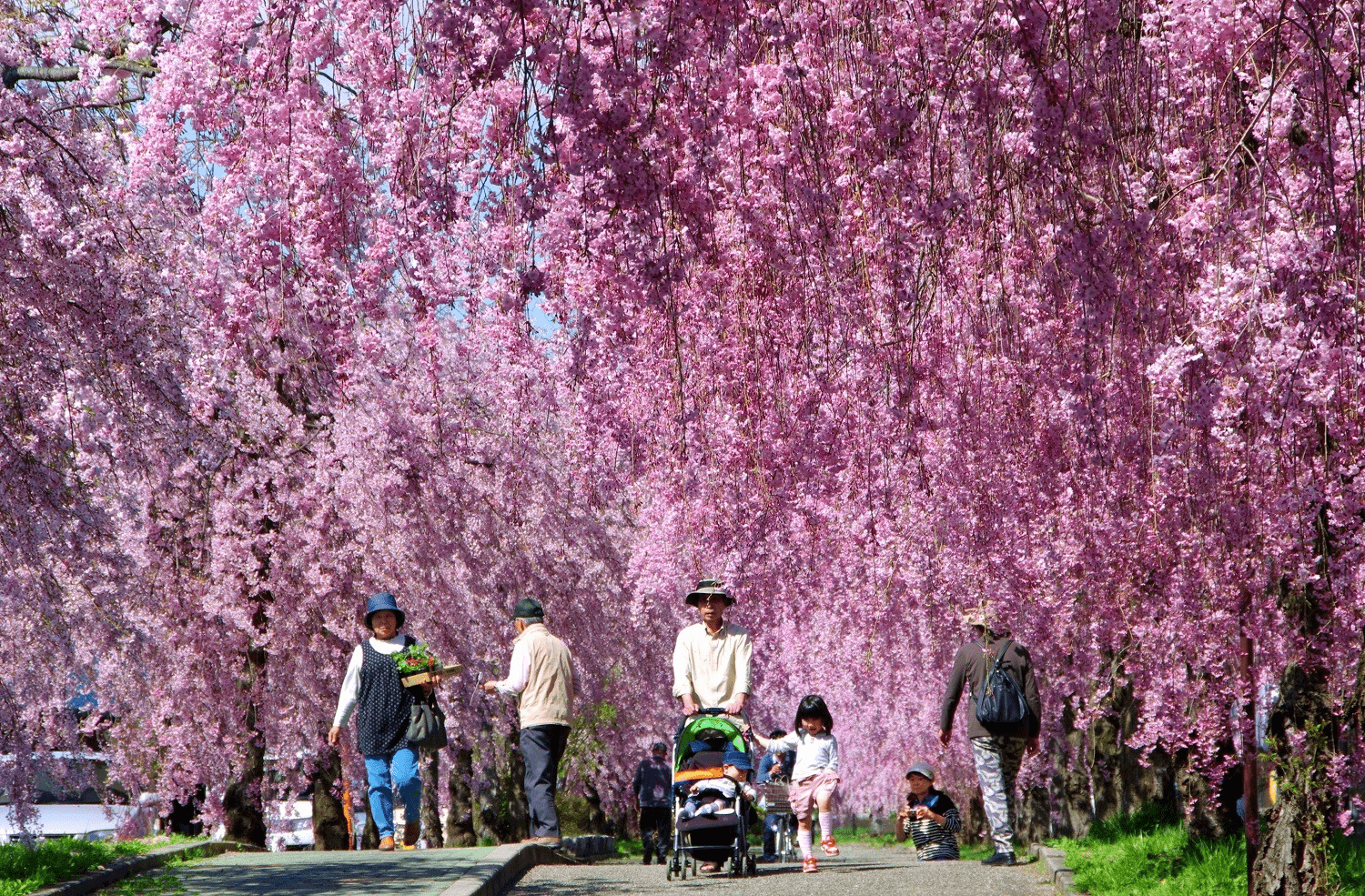
Photo: Kitakata Tourist Product Association
Halfway along the long line of weeping cherry blossom trees which is said to be one of the greatest in Japan, you will come across an old steam locomotive that actually ran on the old Nicchu Line on display. Not only can visitors get a rare close-up look at the steam locomotive, but they can also capture the weeping cherry blossoms and the steam locomotive together with their cameras.
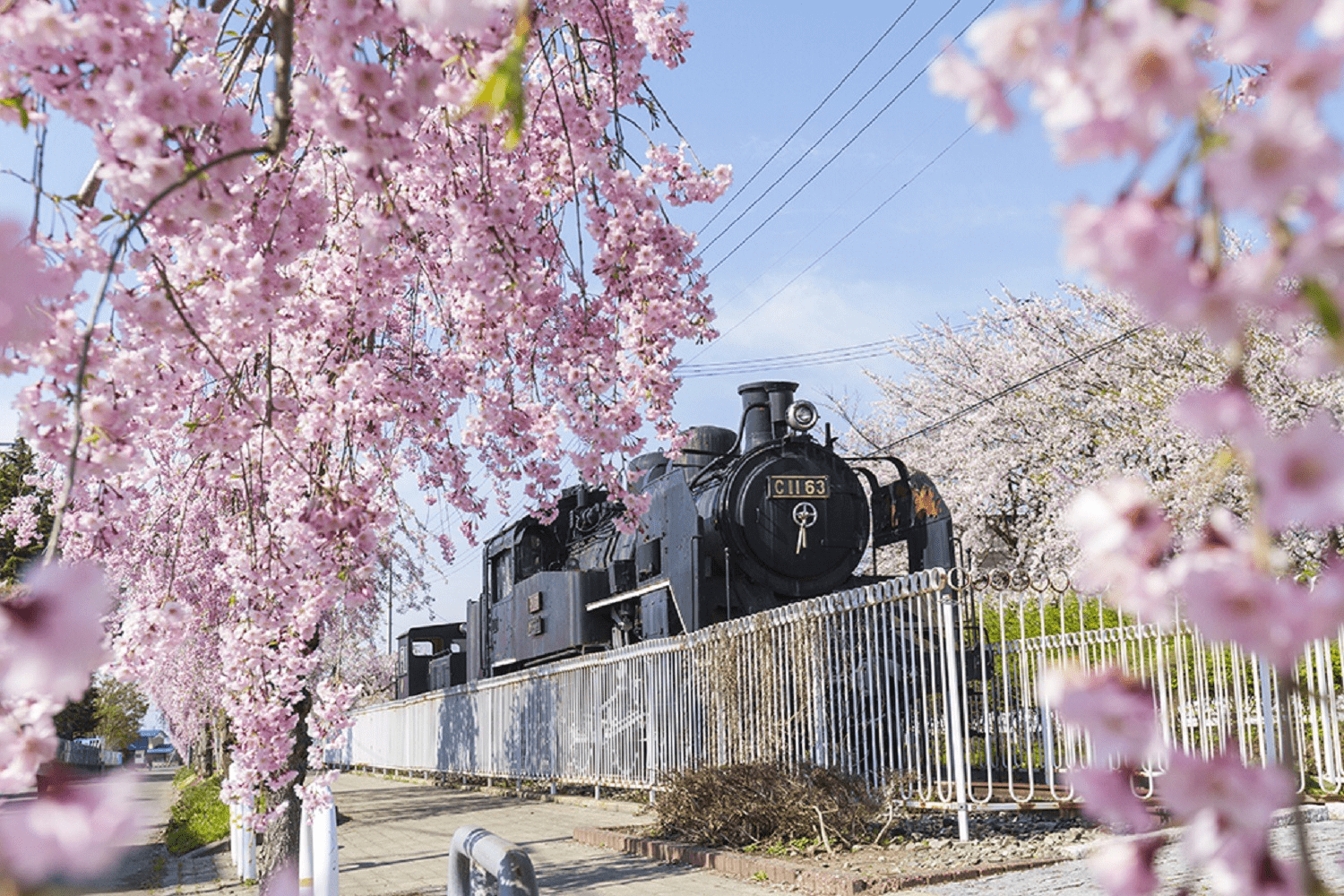
The Nicchu Line weeping cherry blossoms are usually at their best from mid to late April. The Kitakata Cherry Blossom Festival is held in early to late April to coincide with the blooming period, during which time the weeping cherry blossom trees are illuminated at night.
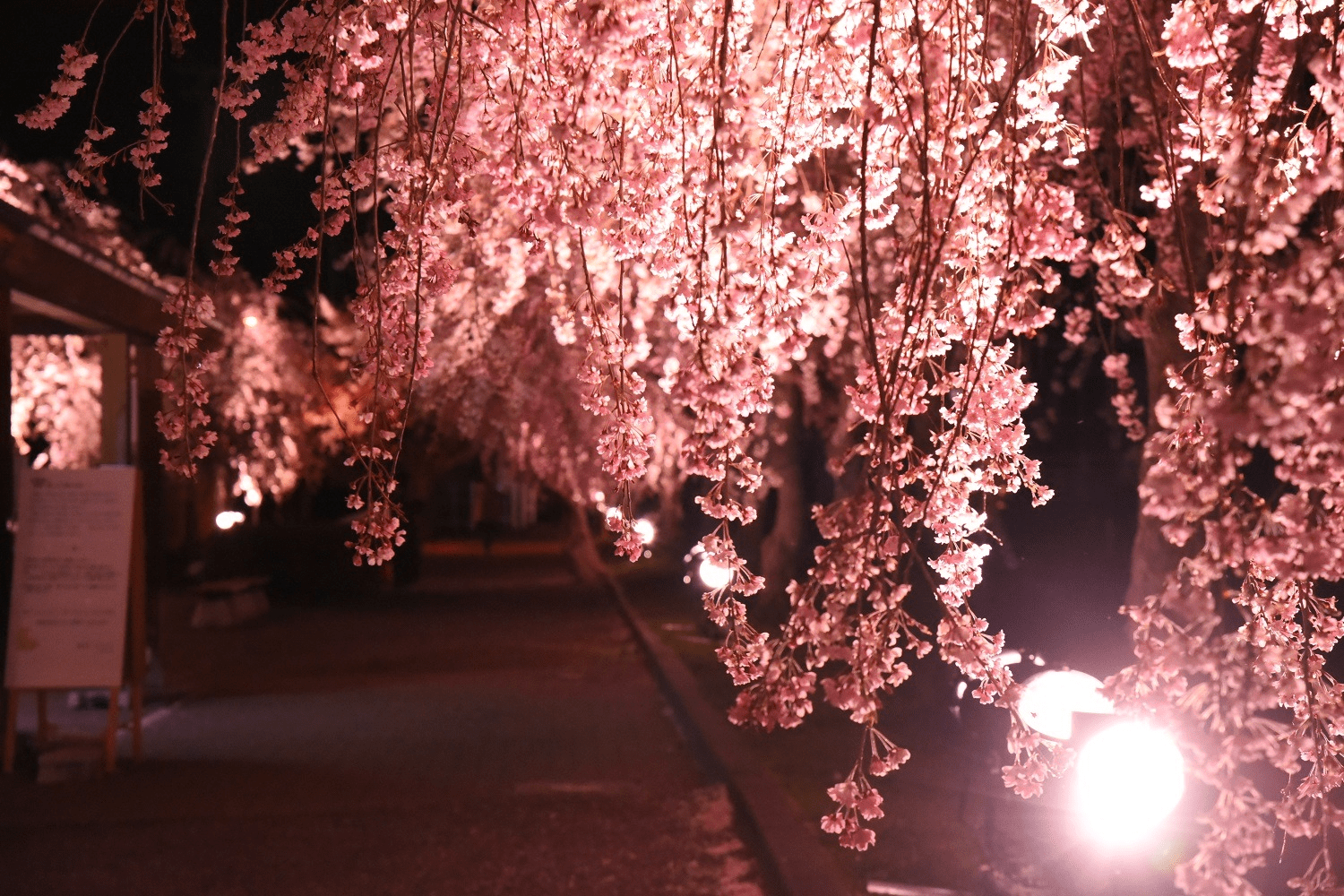
Kitakami Tenshochi Park Features Breathtaking Bird-eye Views of Rows of Cherry Blossoms (Iwate)
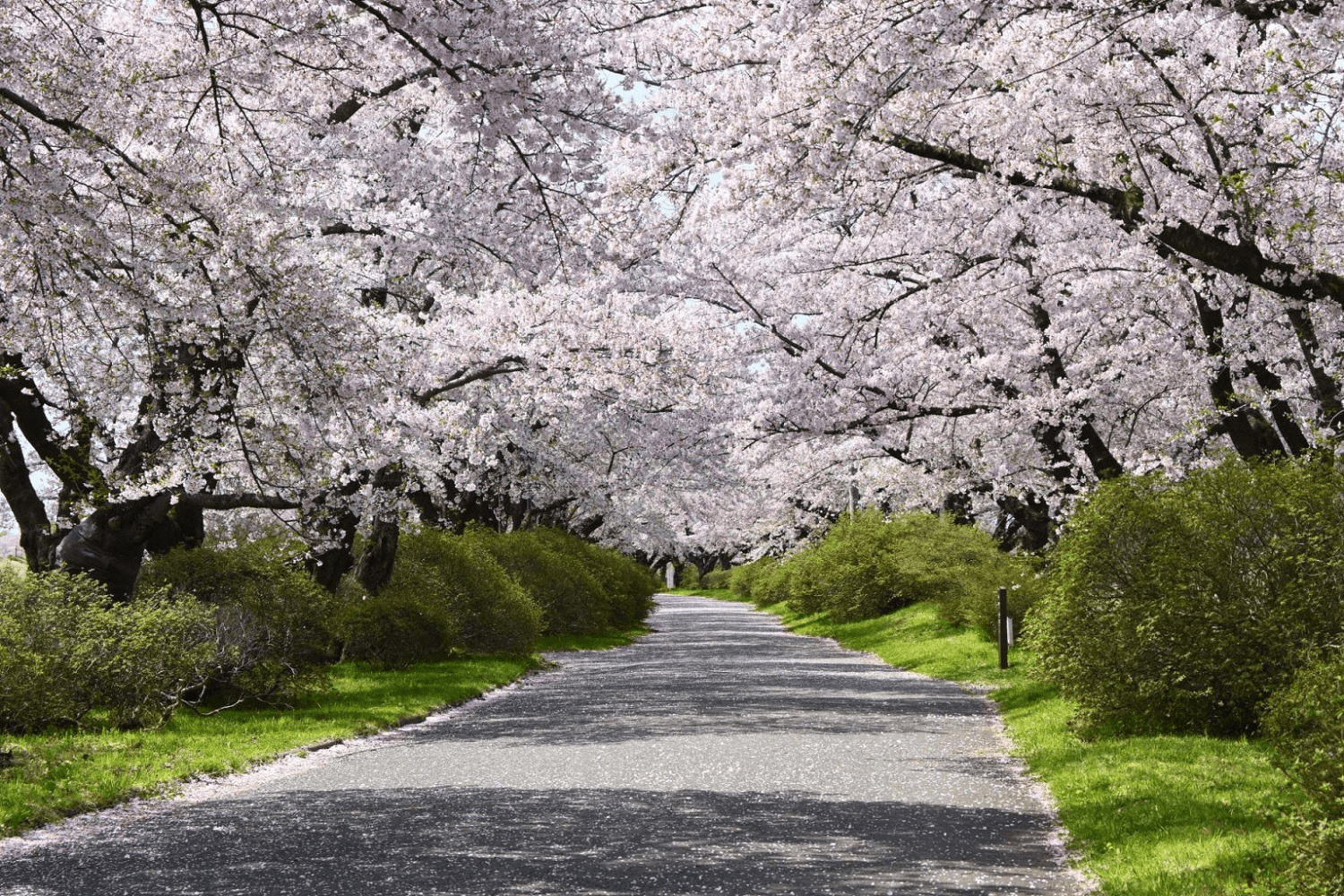
Kitakami Tenshochi Park (Kitakami City Park Tenshochi) is located on the shore of the Kitakami River in the center of Iwate.The name "Tenshochi", which means "scenic spot with a fine view," was chosen because of the magnificent view from the small hill called Jingaoka, which is located within the park.
The vast 293 hectare park is planted with approximately 10,000 cherry blossom trees, and is a well-known cherry blossom viewing spot. There are as many as 150 varieties of cherry blossom trees here and visitors can enjoy a diverse array of cherry blossoms, from Somei Yoshino which begin to bloom in mid-April, to Kasumizakura which bloom towards the start of May.
The park's greatest attraction is the 2km-long row of cherry trees that starts at the foot of the Sango-Bashi Bridge on the left bank of the Kitakami River. Here, cherry blossoms bloom on both sides of the promenade along the river, and visitors can stroll through the rose-colored arches. The Kitakami Tenshochi Cherry Blossom Festival is held in time with the blooming of the cherry trees, and during the festival, old-fashioned carriages are driven through the tunnel of cherry blossom trees. Swaying along with the horse-drawn carriage during the 20-minute ride, visitors are able to enjoy the cherry blossoms from a different perspective to that which they would experience on foot. The area is lit up at night, offering a fantastic view unlike that of the daytime.
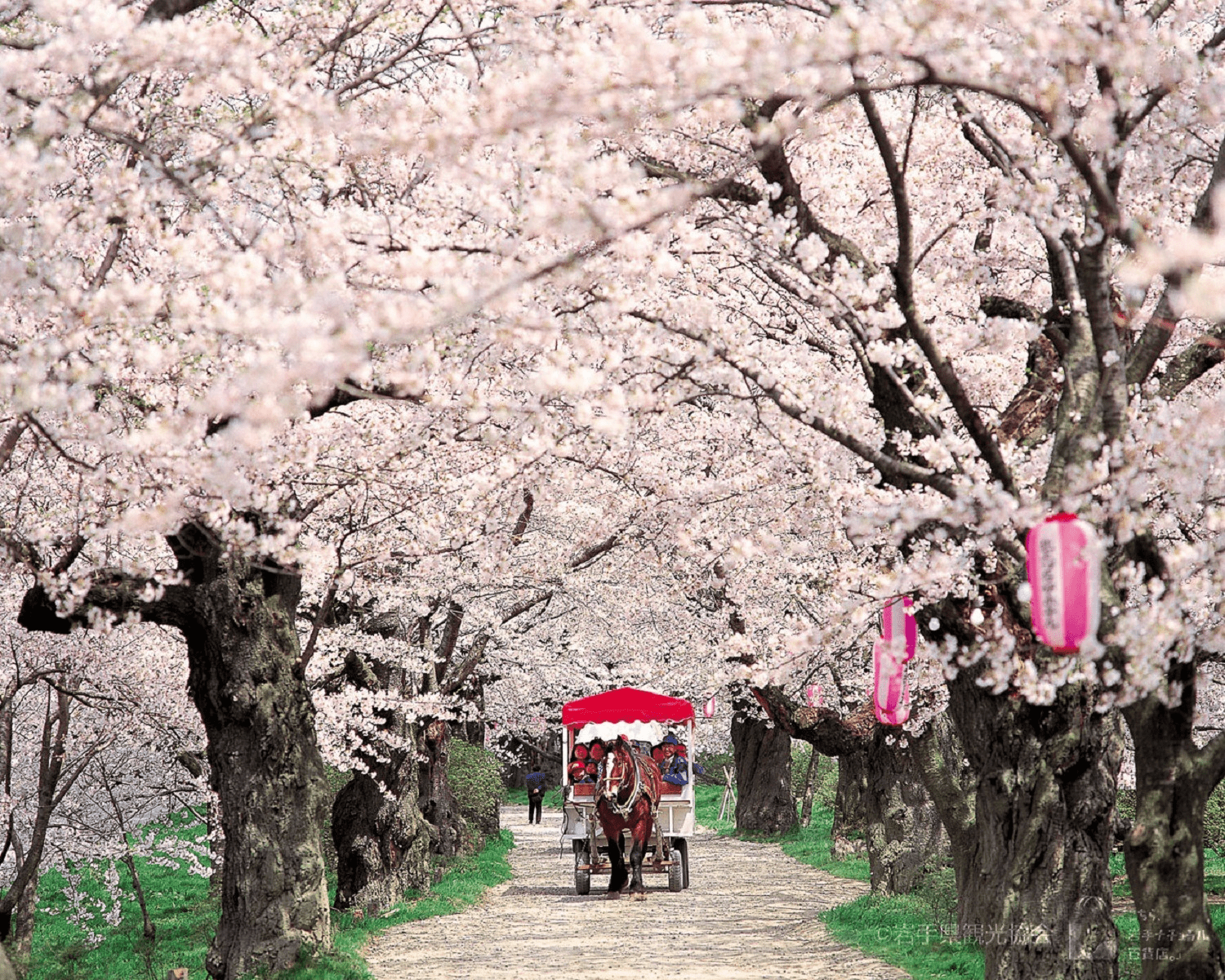
The festival period also coincides with Children's Day on the 5th of May, when around 300 carp streamers (called Koinobori) swim through the sky above Kitakami River. The sight of hundreds of carp streamers dancing in the wind across the river is breathtaking! The streamers can also be seen from the promenade, so be sure to keep an eye on the riverbank!
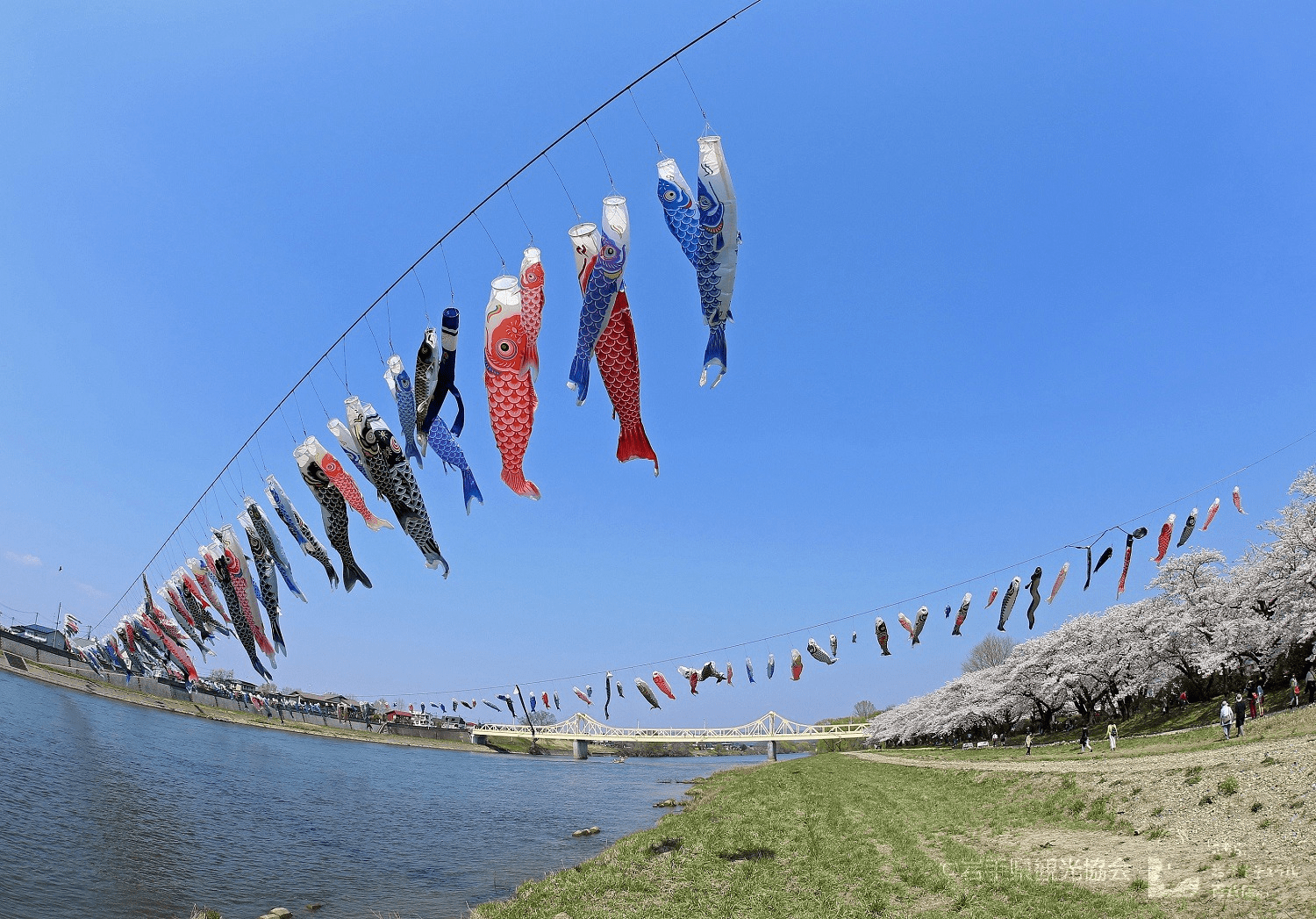
Jingaoka Hill, where you can view the tunnel of cherry blossoms from above, is another recommended spot. From here, visitors can enjoy the spectacular view of the cherry blossoms which bloom alongside the Kitakami River stretching far into the distance. If you move your eyes to the near view, you can see rare species of cherry blossoms with yellow petals, as well as fragrant blossoms in the immediate vicinity.
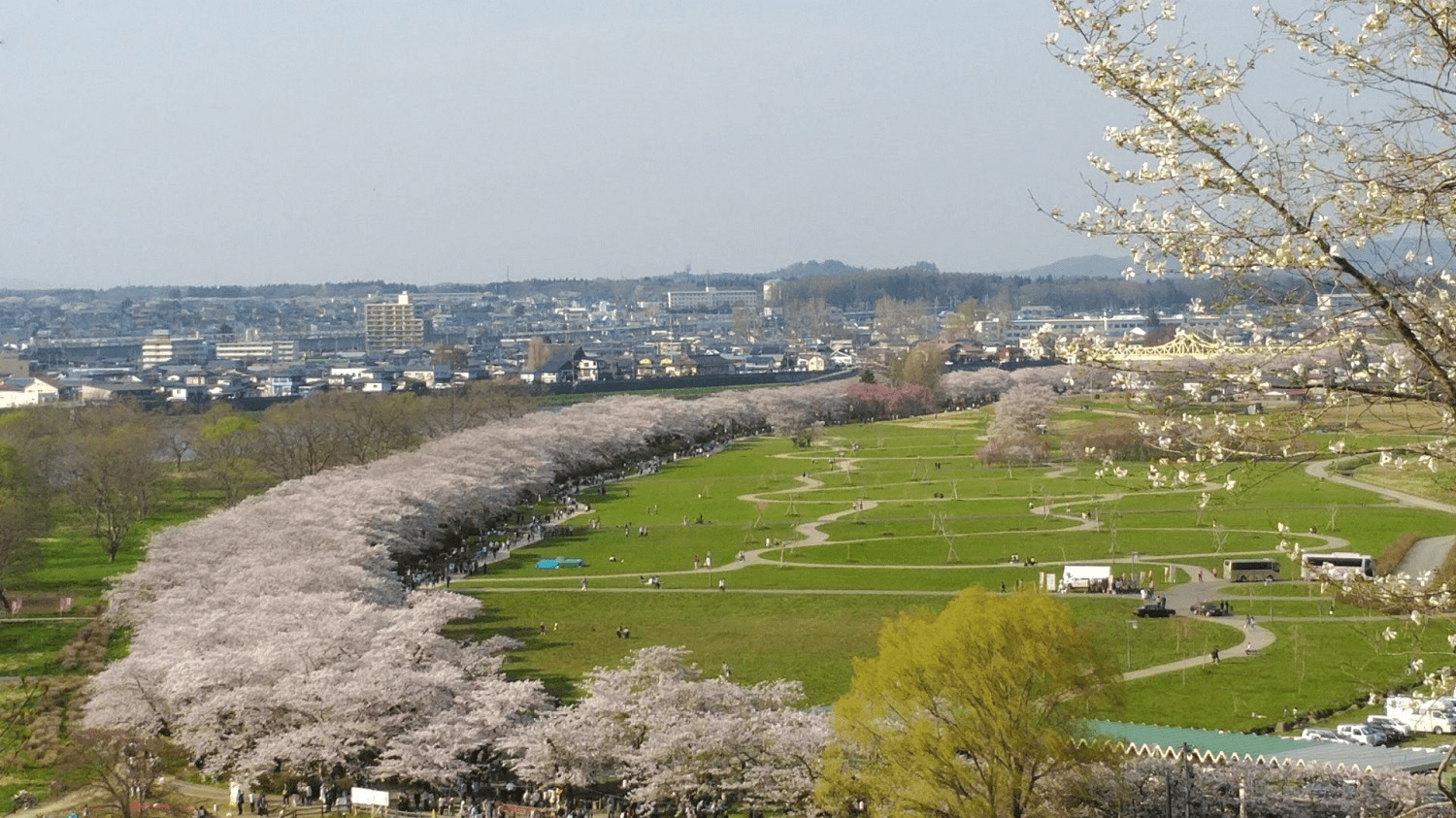
Kitakami Tenshochi's cherry blossoms can usually be seen at their best around mid-April. The Kitakami Tenshochi Cherry Blossom Festival is held when the cherry blossoms come into bloom (from around April 15 to April 30 on an average year).
Cherry Blossoms Bloom Around Elegant Kakunodate, "Tohoku's Little Kyoto" (Akita)
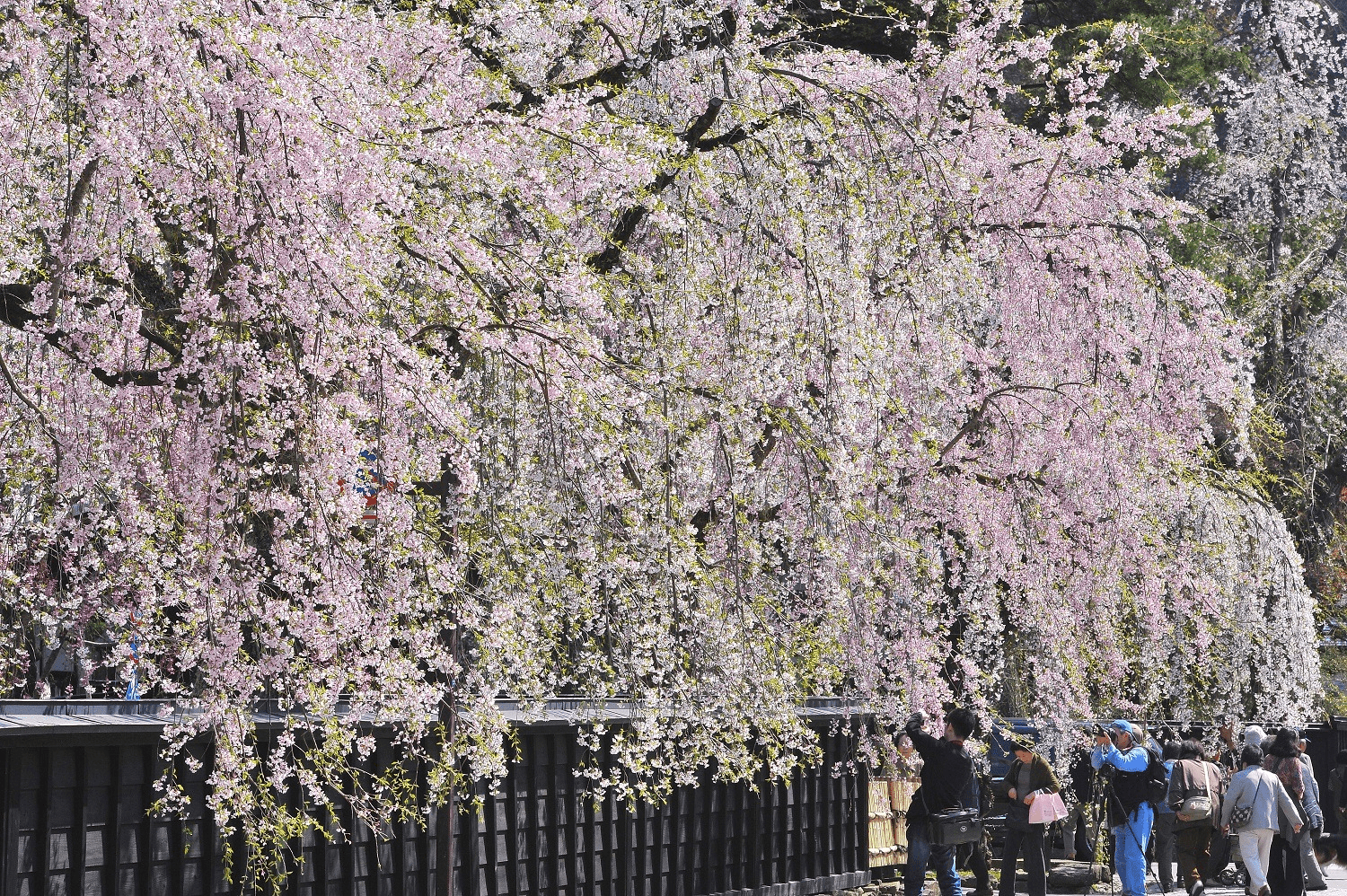
Kakunodate in Semboku City, Akita, is a popular sightseeing spot that has retained the appearance of a castle town from Japan's feudal era. Lined with deep groves of trees and massive black wood panel fences, the area, known as Bukeyashiki-dori, retains the samurai residences and townscape of the past.
Bukeyashiki-dori is also known as a great cherry blossom viewing spot. The highlight of the area is the deep pink weeping cherry blossoms that stand out against the black-paneled walls of the samurai residences. These cherry blossom trees are said to have originated from three weeping cherry saplings that were included in the wedding present of the wife of Yoshiaki Satake, the second generation of the Satake Kita family who ruled Kakunodate, when she came from Kyoto to marry into the family.
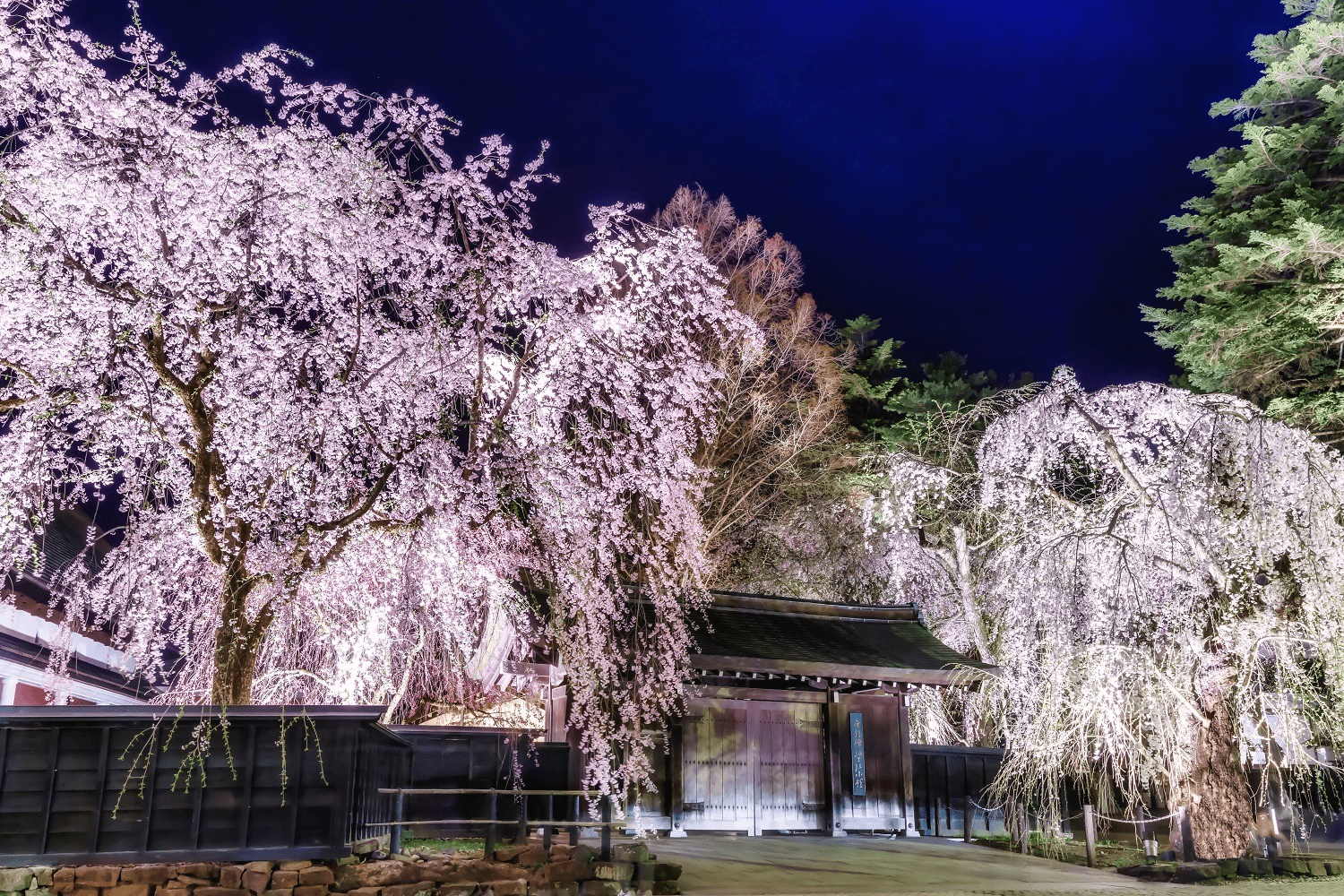
Of the 400 or so weeping cherry trees which bloom in Kakunodate, currently 162 are designated as National Natural Monuments. The elegance of the castle town is heightened by the sight of the buds on the gracefully spreading branches all blooming at the same time, dyeing the town cherry blossom pink. To gain a deeper appreciation of the cherry blossoms in the historic town of Kakunodate, renting a kimono and viewing the blossoms in kimono is another exciting option. You will feel the town's Japanese atmosphere even more strongly if you take a rickshaw ride while wearing a kimono.
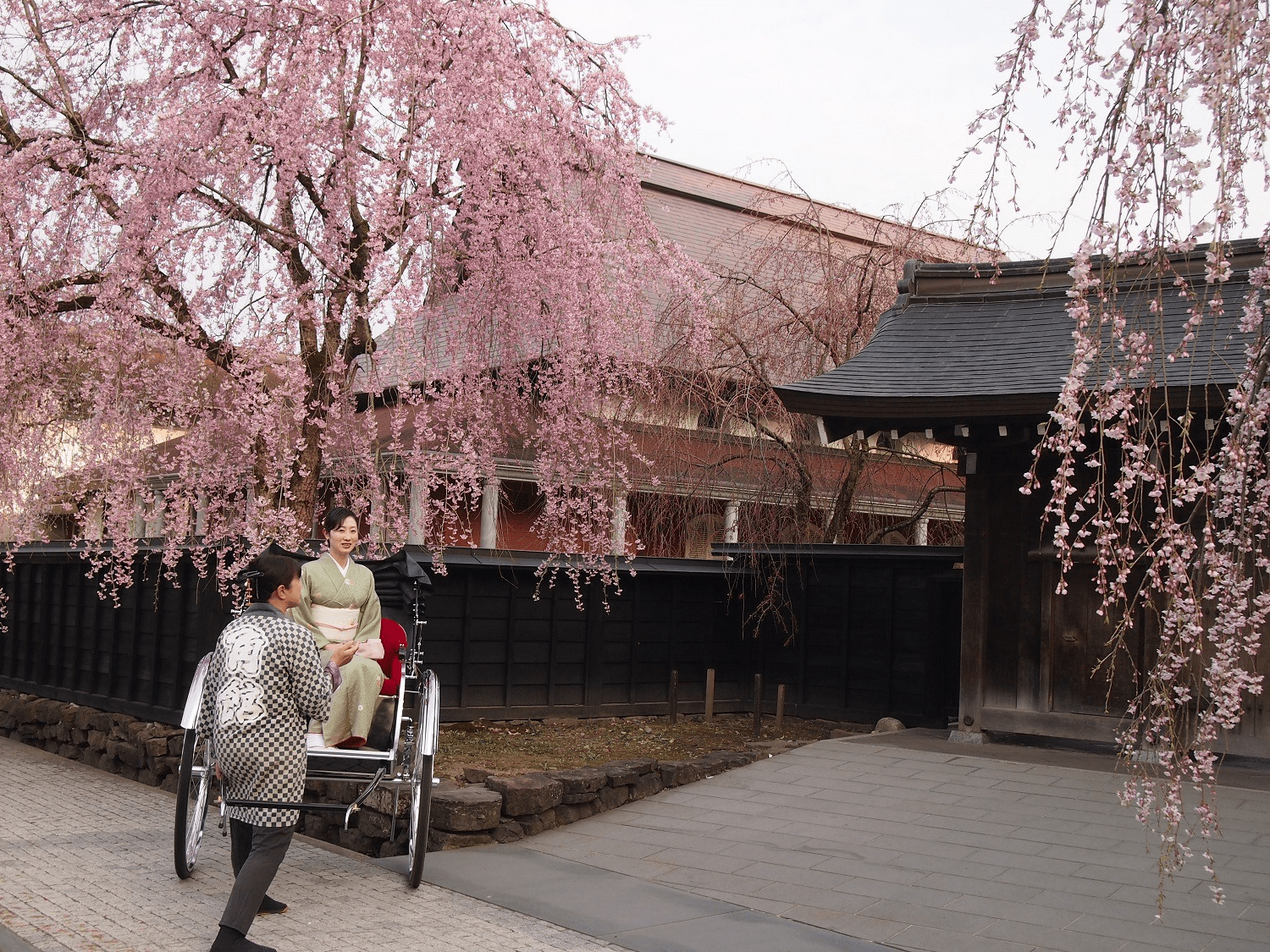
Kakunodate has one more famous cherry blossom viewing spot. Located not far from Bukeyashiki-dori, the rows of cherry blossom trees along the banks of the Hinokinai River were planted in 1934 to commemorate the birth of His Majesty the Emperor Emeritus. Today, 400 cherry trees can be seen in full bloom along a 2-kilometer stretch of the left bank of the Hinokinai River, and visitors can enjoy spring in this little version of Kyoto as they walk through the tunnel of cherry trees along the gently meandering river.
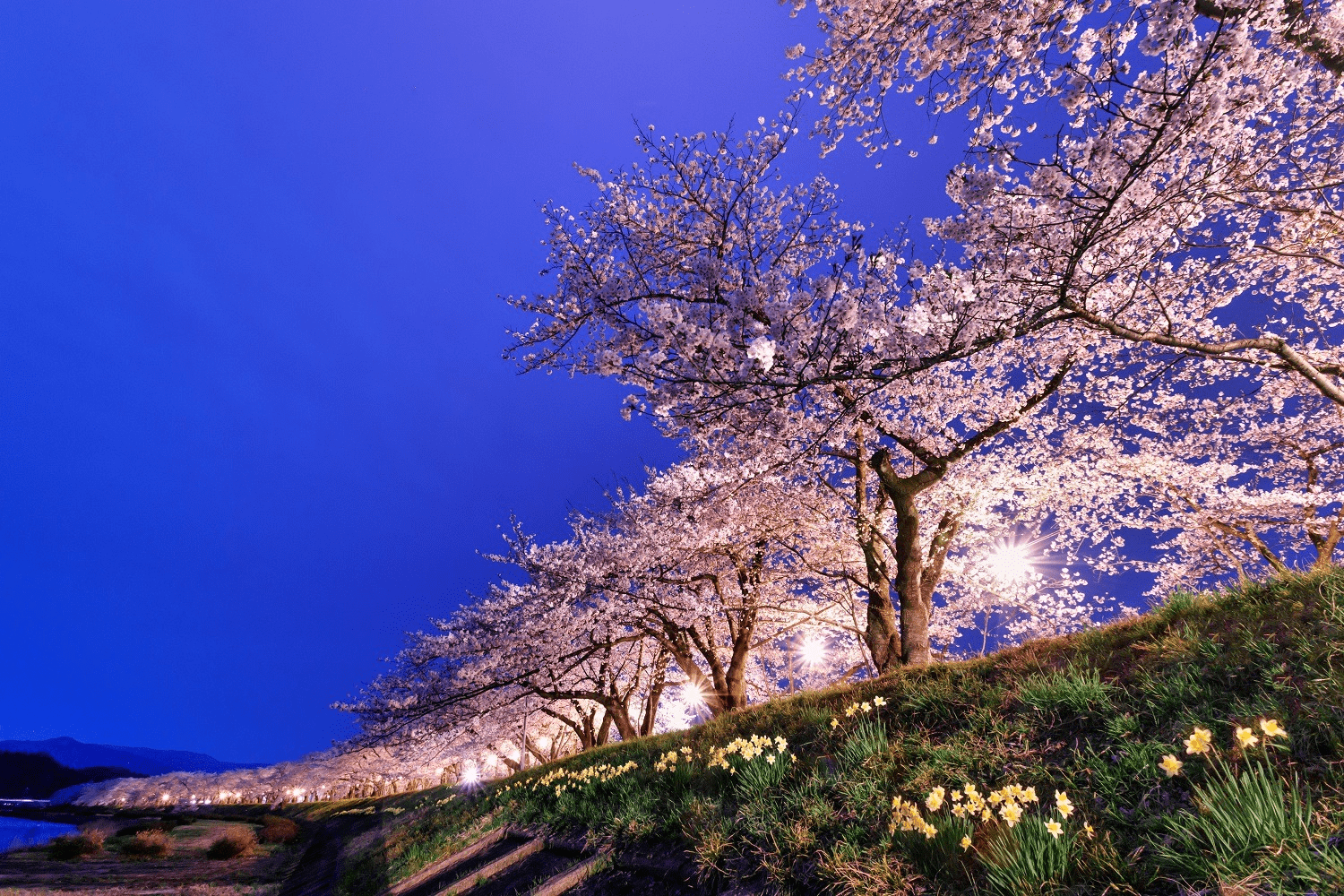
The cherry blossoms in Kakunodate are usually at their best from mid to late April, and the 2024 Kakunodate Cherry Blossom Festival is tentatively scheduled to be held from April 15 to May 5, 2024, during which time Bukeyashiki-dori and the Hinokinai River bank will be lit up at night.
Hirosaki Park is Dyed Pink in Japan's Greatest Scenery! (Aomori)
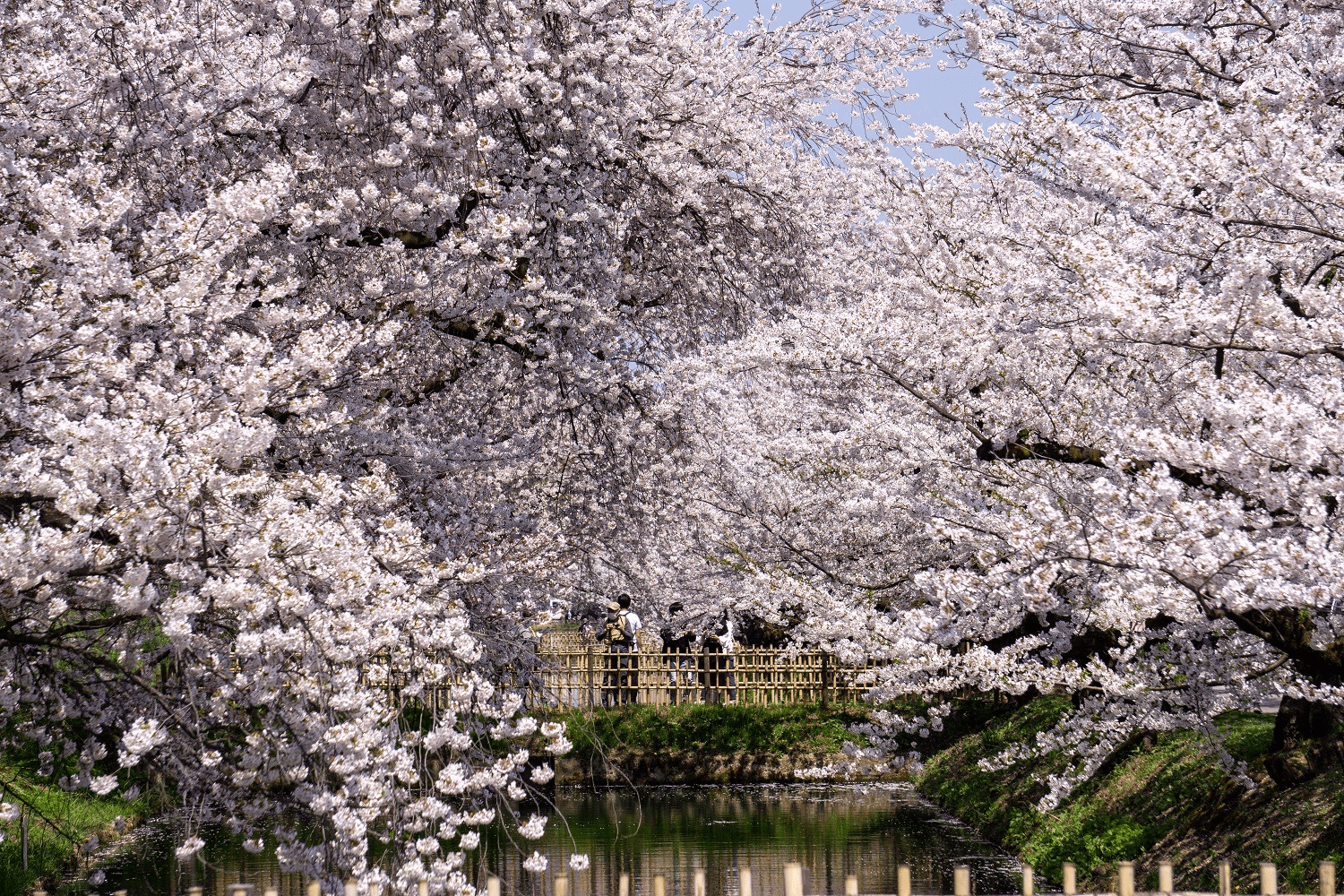 Photo: Hirosaki Park Website
Photo: Hirosaki Park Website
Hirosaki Castle in Hirosaki City of Aomori Prefecture was built during the Edo Period, and the castle's keep, gates, and corner turrets which exist to this day are reminiscent of a bygone era. Today the castle is maintained as a part of Hirosaki Park, and during the cherry blossom season visitors can enjoy some spectacular scenery that many consider to be the greatest in Japan.
There is certainly a reason why many say that this is the greatest scenery in Japan. The main source of visitor's admiration are the 2,600 cherry blossom trees of 52 species that bloom in the park. The cherry blossom trees in the park produce a greater number of flowers from a single bud than cherry trees in other areas, and so the petals are more densely layered. The branches spread low and full horizontally, and each branch produces a large number of flowers. The entire park dyed pink by these gorgeous and voluminous blossoms is an overwhelmingly beautiful sight. This beauty is said to be the result of a unique management method that applies management techniques for apple trees, of which Hirosaki City is the largest producer in Japan, and the efforts of "Team Sakuramori" which takes sole responsibility for the trees' management.
Hirosaki Park is also known for its many cherry blossom viewing spots throughout the park. A must-see spot is the area around the castle keep, which currently stands on a temporary base due to ongoing renovation work. This area offers an excellent view of the castle keep, cherry blossoms, and Mt. Iwaki in the background.
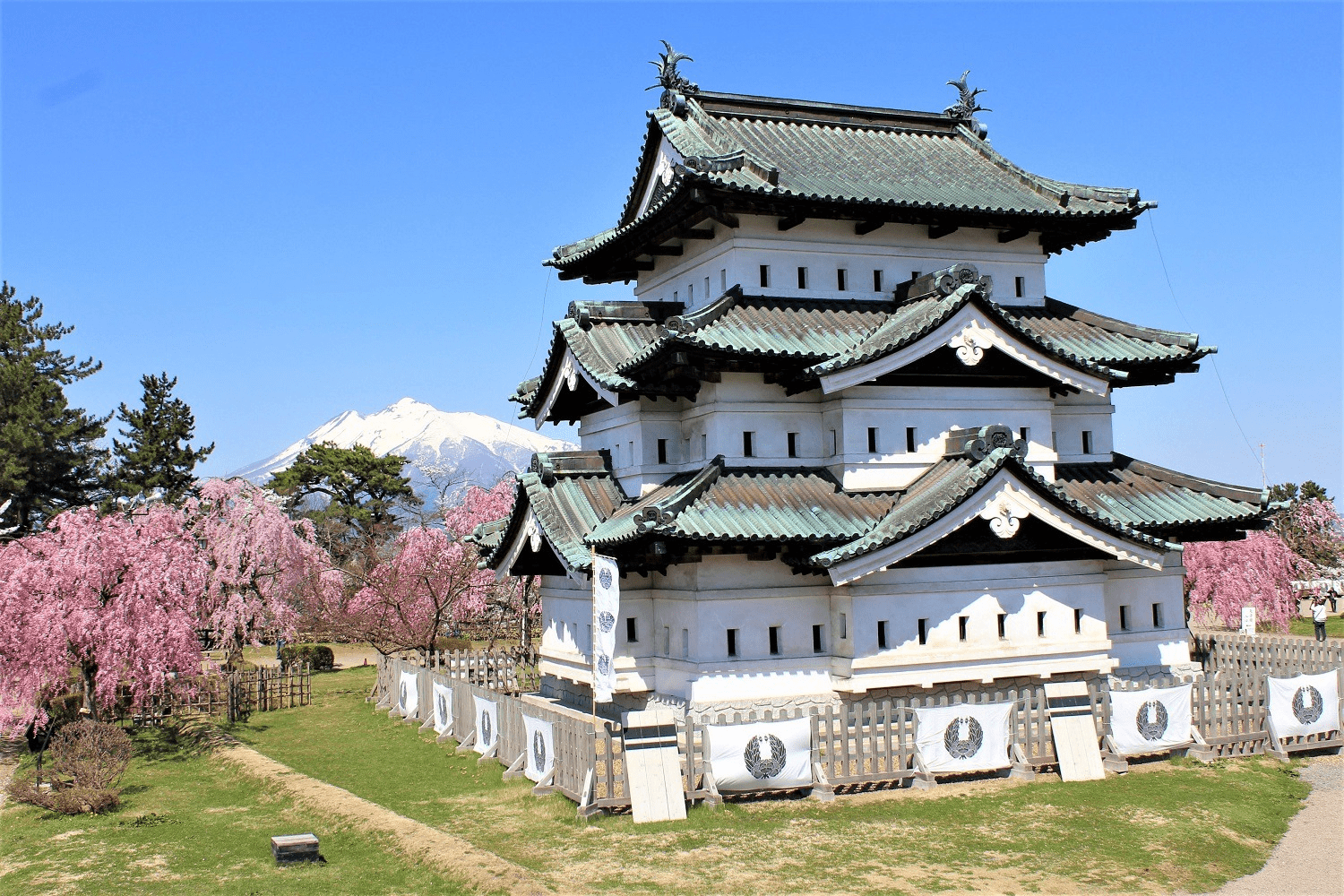
The walking path along the west moat that surrounds the western perimeter of the park is popular for its cherry blossom tunnel. Here, cherry blossom trees line both sides of the pathway, and when they are in full bloom, visitors can admire the flowers as they walk through a tunnel of cherry blossoms. The West Moat is illuminated at night to provide a fantastic view of the cherry blossoms reflected in the water's surface.
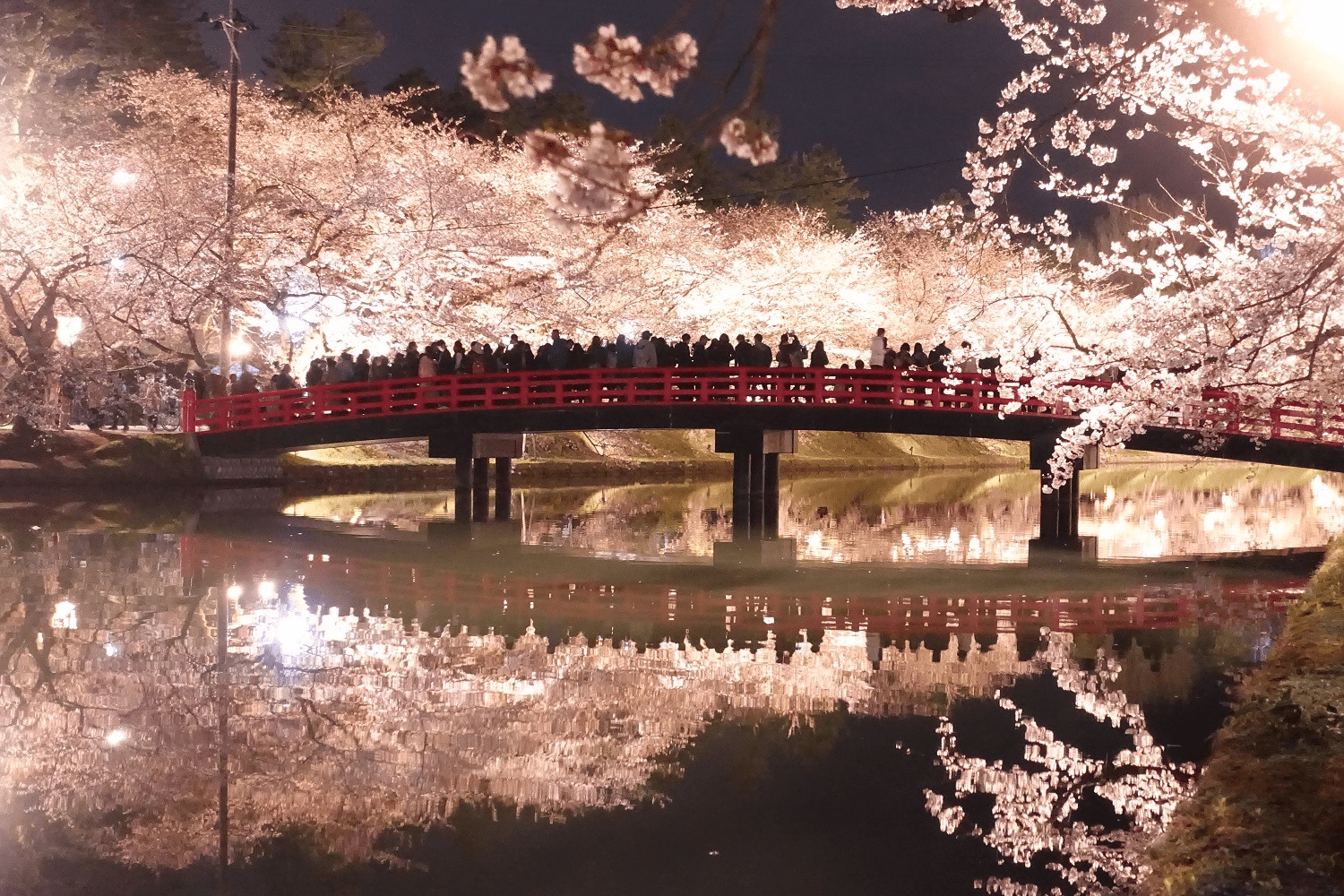
Photo: Hirosaki Park Website
Furthermore, the outer moat which surrounds the perimeter of the park is a famous spot not only when the cherry blossoms are in full bloom, but also for its beautiful flurries of falling cherry blossoms, and the fallen petals that coat the surface of the water. Another sight which is popular on social media is the "cherry blossom heart," where two cherry blossom branches overlap, forming a heart shape.
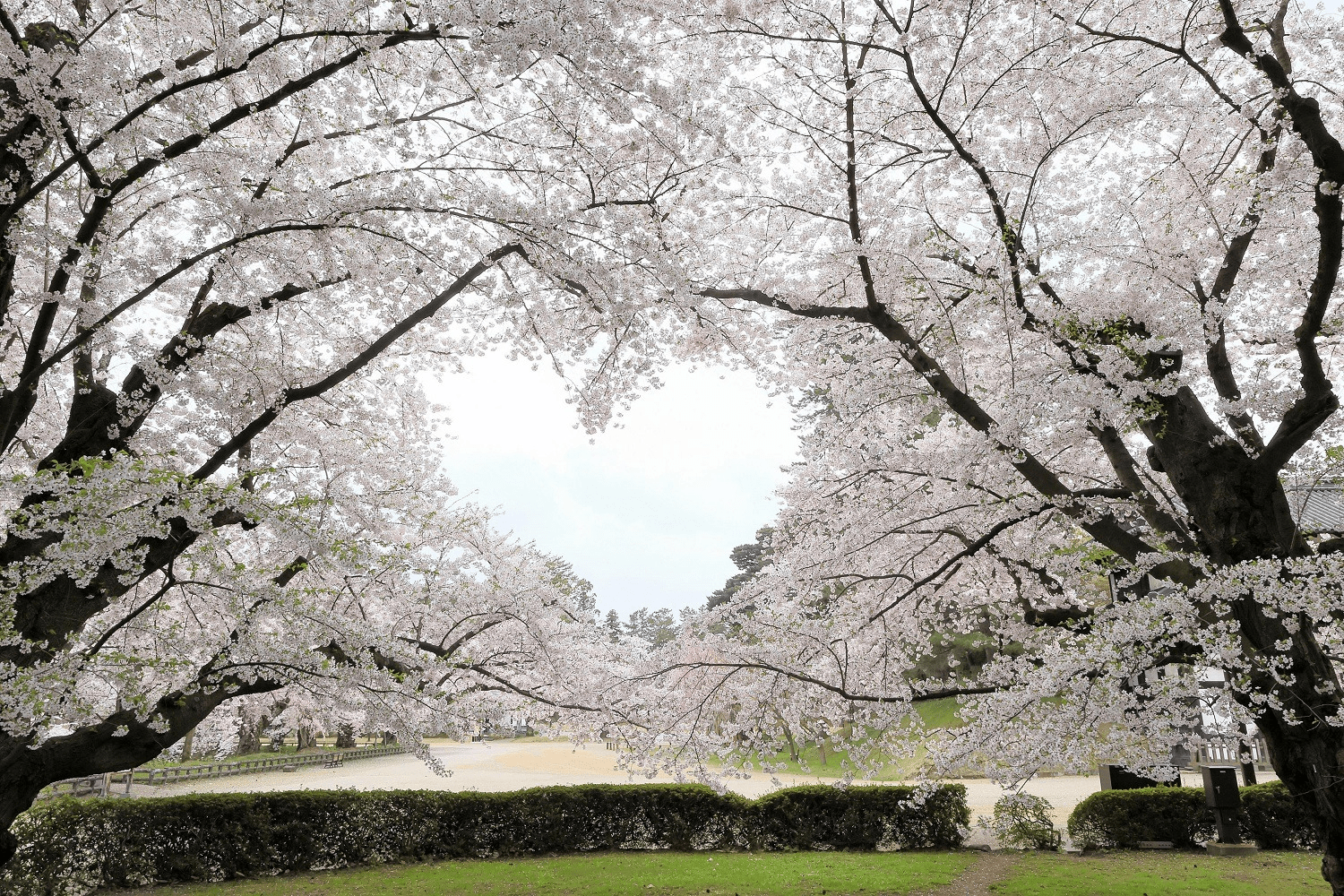
Hirosaki Park's cherry blossoms can usually be seen at their best from late April to early May. The 2024 Hirosaki Cherry Blossom Festival is due to be held from April 19 to May 5, 2024.
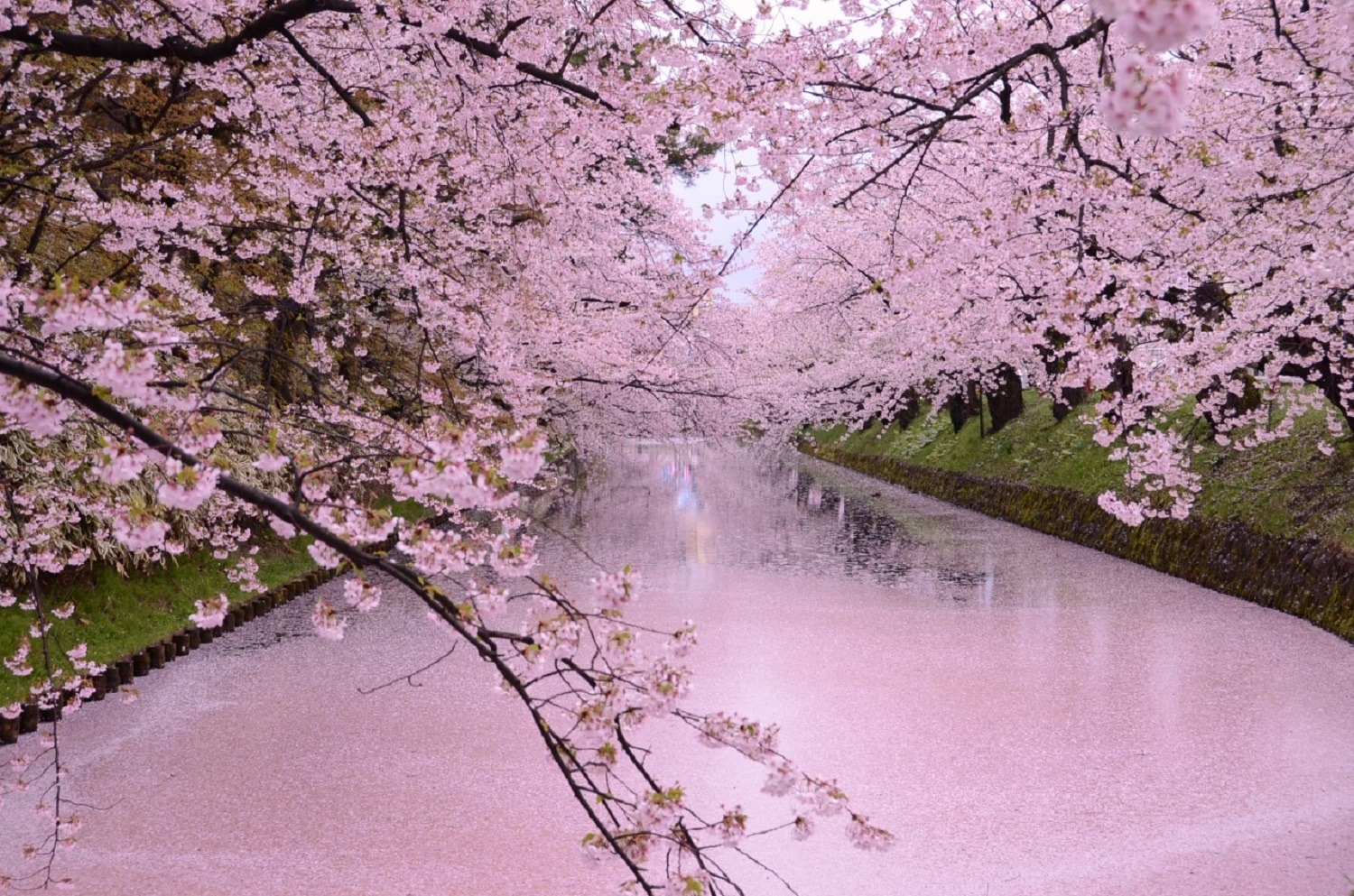
*This information is correct as of December 12 2023. Content is subject to change according to this year's conditions.
Follow the Cherry Blossom Front by Traveling the Length of Tohoku from South to North!
Even if you missed the cherry blossoms in Tokyo or Osaka, you may still be in with a chance to enjoy them if you head over to the Tohoku area, a long stretch of land reaching from south to north. Why not try following the cherry blossoms in Tohoku from south to north using the information provided by the Japan Meteorological Agency!